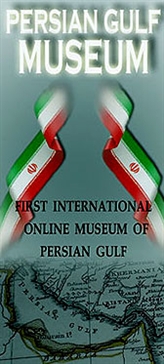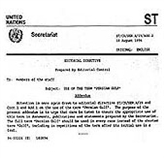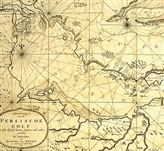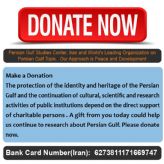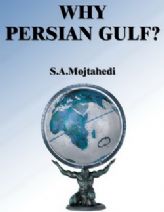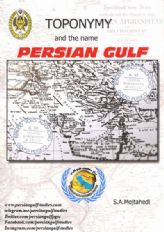Museum of Sassanid Iran
Some Part of Sassanid Treasures
(224 CE – 651 CE)
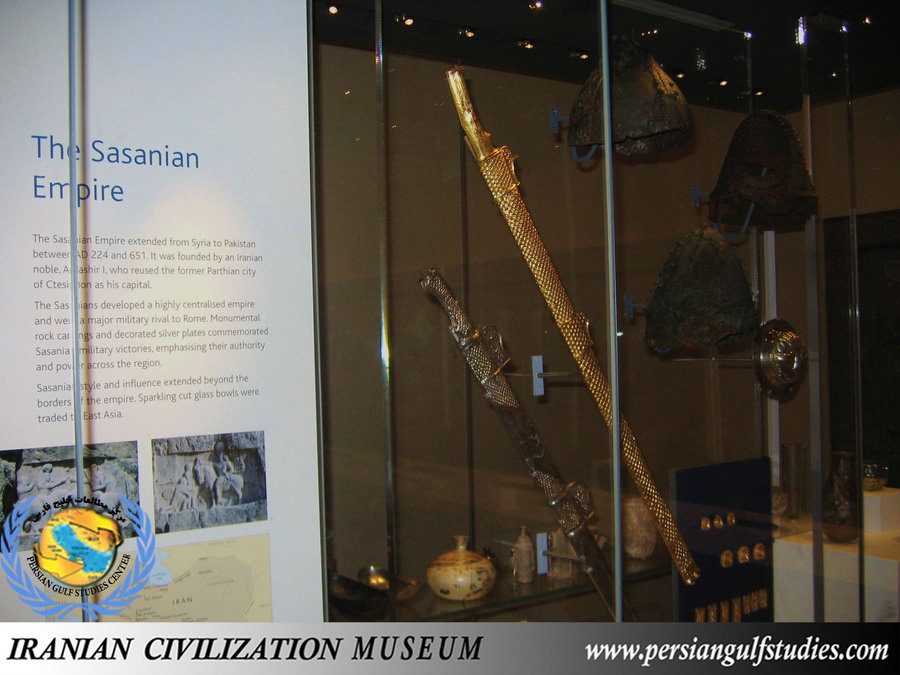 Gold Sword of Sassanid king, ca. 6th century A.D.British Museum.
Gold Sword of Sassanid king, ca. 6th century A.D.British Museum.
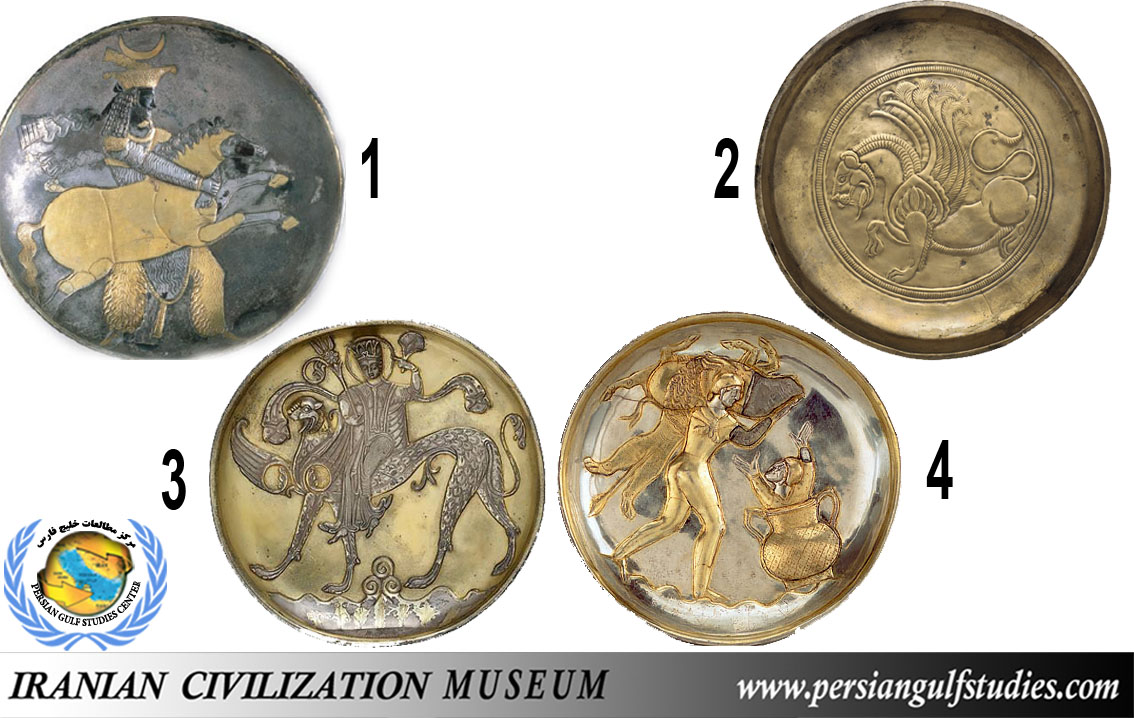 1. The plate with the king of the Sassanid design, silver gilt, Miho Museum.
1. The plate with the king of the Sassanid design, silver gilt, Miho Museum.
2. Sasanian Simurgh Plate, Bronze, 7th century, Smithsonian Institution.
3. Plate Depicting a Female Figure Riding a Fantastic Winged Beast, Inspired by the Sasanian, probably 8th century, Silver; gilded, chased, and engraved, with applied elements, The Metropolitan Museum of Art.
4. Sassanid plate with the boar hunt, Silver gilt fifth to the seventh century, George Ortiz Collection
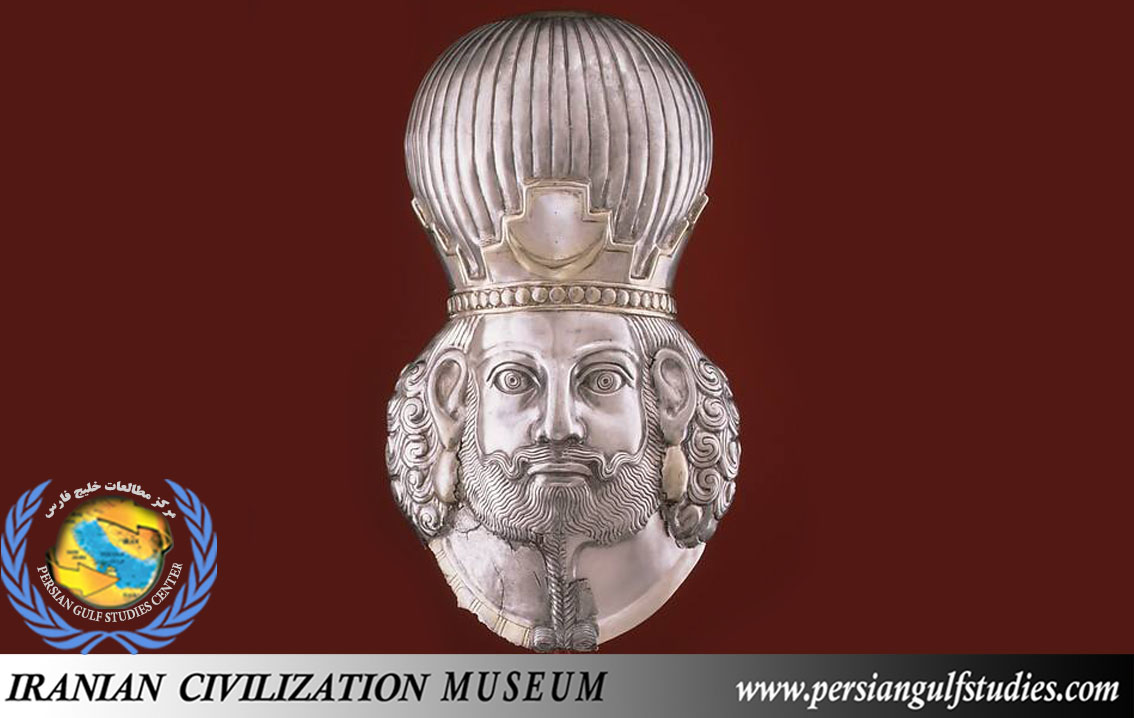 Head of Shapur king, ca. 3th century. Silver, mercury gilding, The Metropolitan Museum of Art. Shapur II, also known as Shapur II the Great, was the tenth king of the Sasanian Persian Empire. The longest reigning monarch of the Sassanid dynasty, he reigned from 309 to 379
Head of Shapur king, ca. 3th century. Silver, mercury gilding, The Metropolitan Museum of Art. Shapur II, also known as Shapur II the Great, was the tenth king of the Sasanian Persian Empire. The longest reigning monarch of the Sassanid dynasty, he reigned from 309 to 379
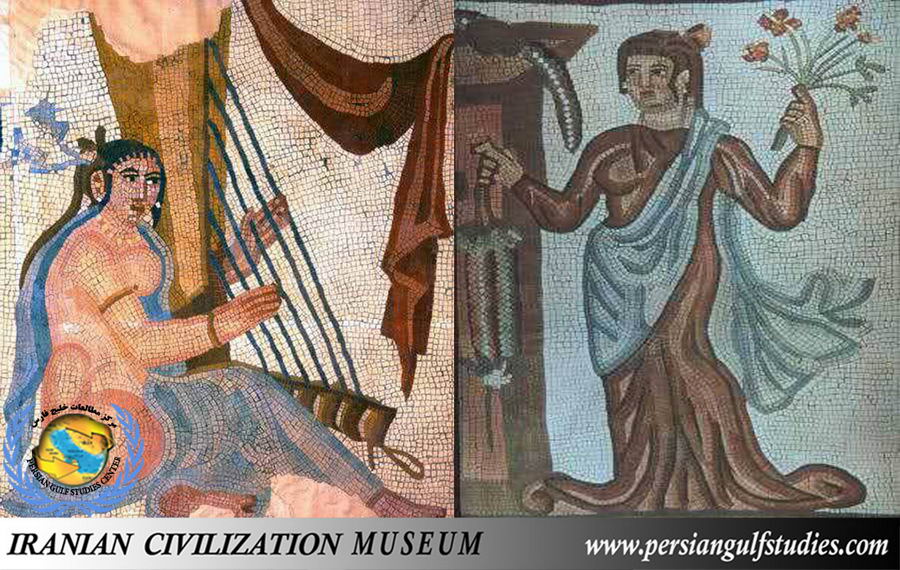 Sassanid mosaic, Bishapur city, Kazerun County of Pars Province, Iran
Sassanid mosaic, Bishapur city, Kazerun County of Pars Province, Iran
 Sassanid Glass with an image of Khosrau II, 6th century
Sassanid Glass with an image of Khosrau II, 6th century
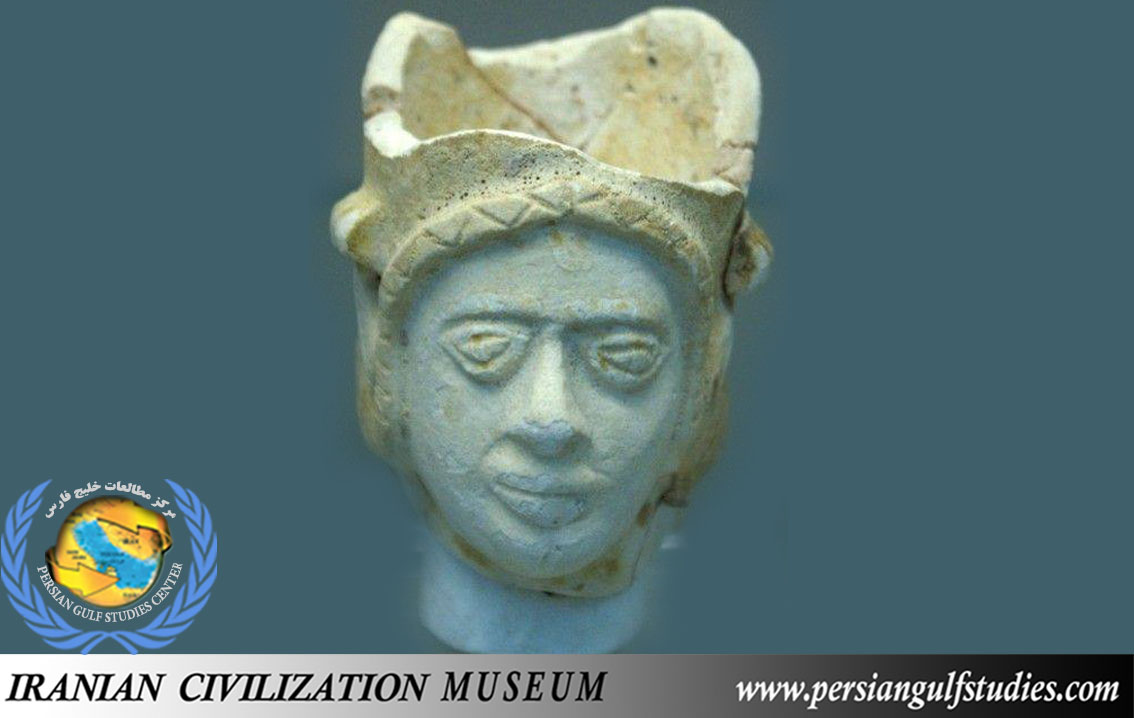 Sasanian woman bust in the Iran Museum
Sasanian woman bust in the Iran Museum
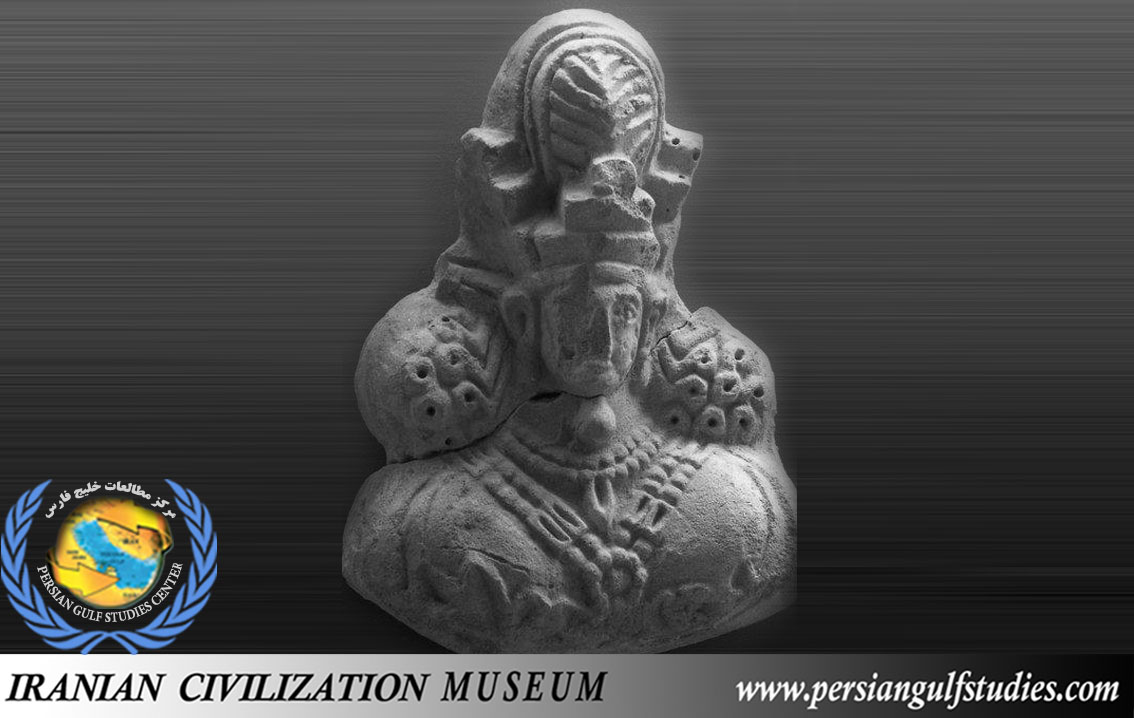 A gypsum bust of a Sassanian king , Shapur II (309-379 A.D.) from Ctesiphon (Salman Paak).
A gypsum bust of a Sassanian king , Shapur II (309-379 A.D.) from Ctesiphon (Salman Paak).
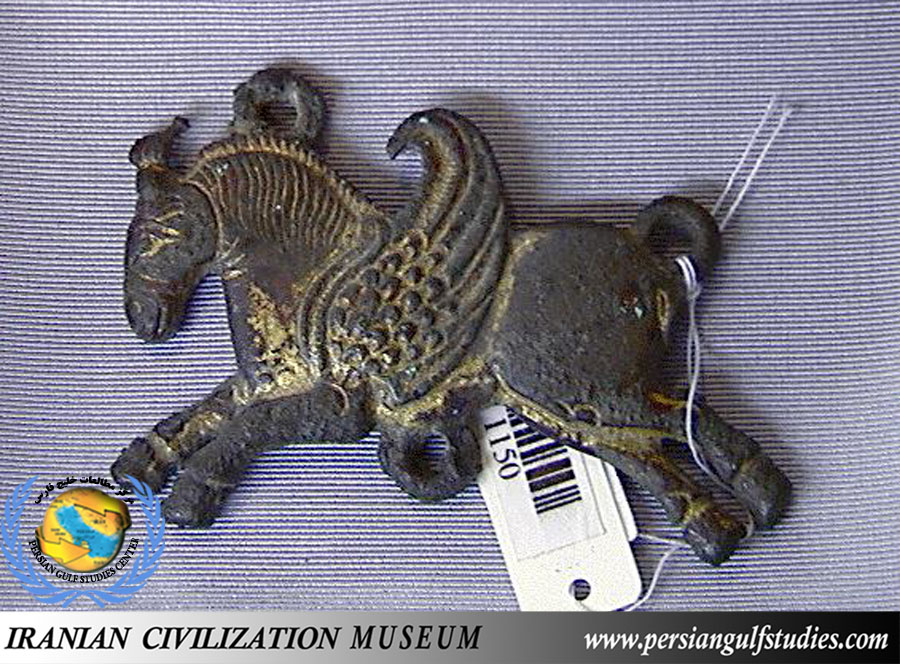 A Sasanian gilt bronze attachment depicting a winged horse, circa 5th to 6th Century A.D.
A Sasanian gilt bronze attachment depicting a winged horse, circa 5th to 6th Century A.D.
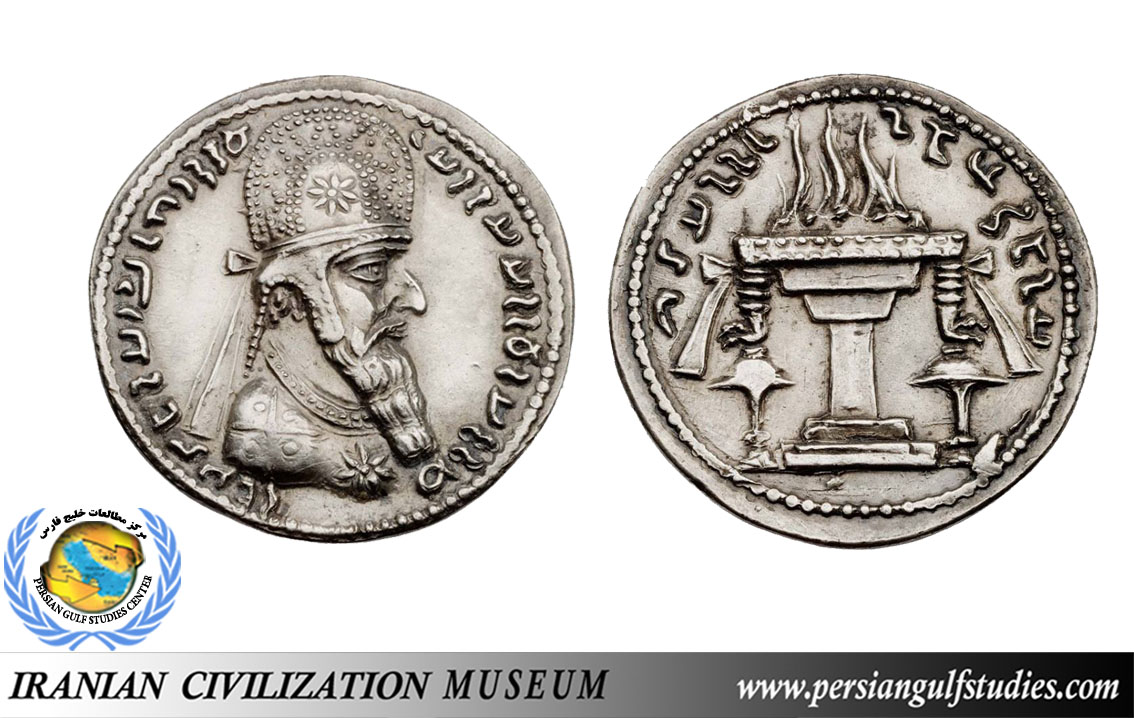 Ardashir I Coin - Silver, A.D. 224–241, Coin depicting the portrait of the Sasanian king Ardashir I (224-241). Museum of Fine Arts, Boston
Ardashir I Coin - Silver, A.D. 224–241, Coin depicting the portrait of the Sasanian king Ardashir I (224-241). Museum of Fine Arts, Boston
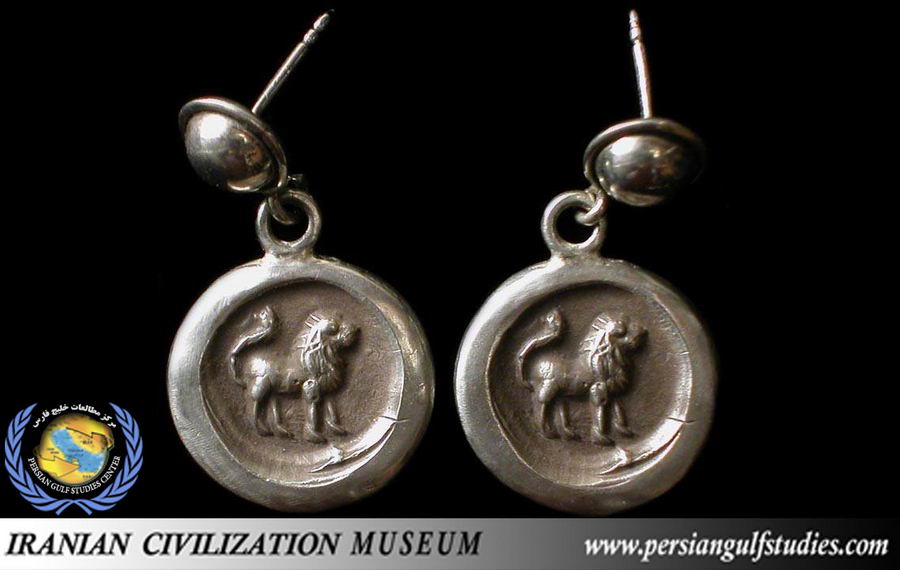 Beautiful solid silver earrings. Ancient Sassanian Persia. 200--500 AD. Lion made from original carnelian seal.
Beautiful solid silver earrings. Ancient Sassanian Persia. 200--500 AD. Lion made from original carnelian seal.
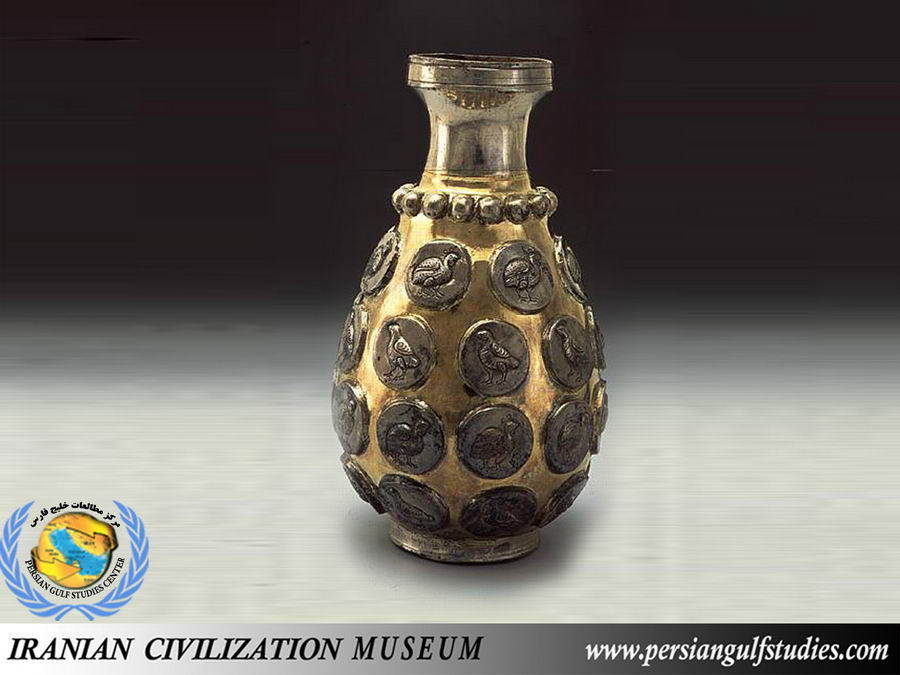 Title Vase with Medallions Enclosing Birds, Sasanian Art, Year 6th to 7th centuries, Silver gilt, MIHO MUSEUM.
Title Vase with Medallions Enclosing Birds, Sasanian Art, Year 6th to 7th centuries, Silver gilt, MIHO MUSEUM.
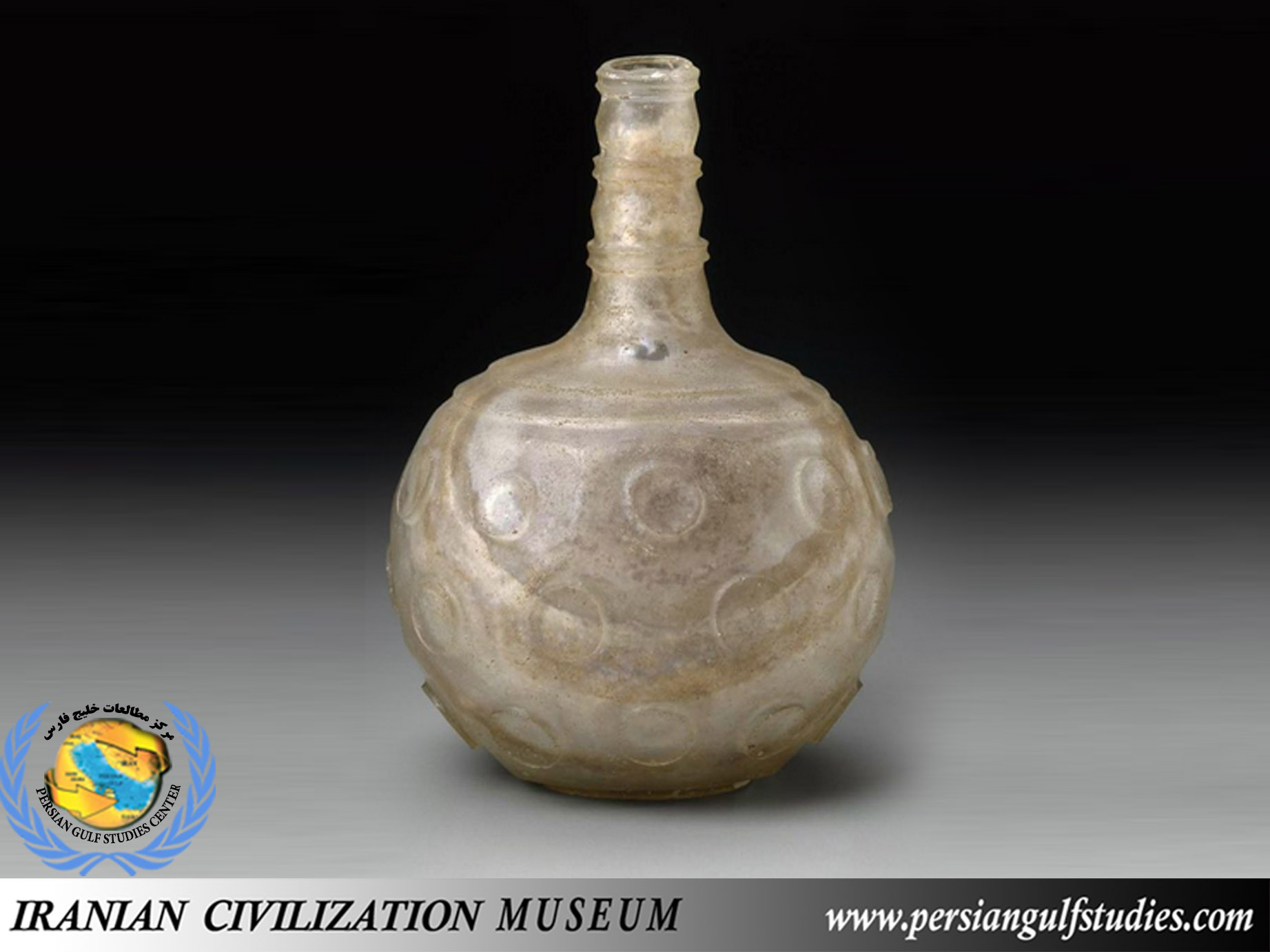 Glass bottle - Sasanian, 6th- 8th century AD, Boston Museum of Art.
Glass bottle - Sasanian, 6th- 8th century AD, Boston Museum of Art.
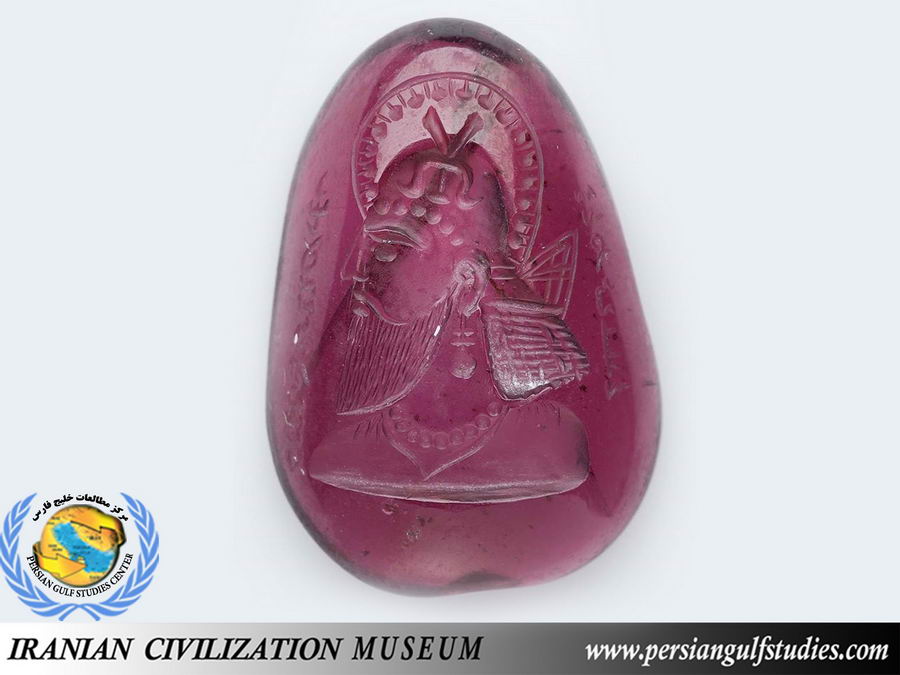 Stamp seal, pear-shaped, Bust of a king, Hormisdas II. On each side an inscription. Garnet, 226 to 561 AD (Sassanid period). Museum of Fine Arts, Boston, Not On View
Stamp seal, pear-shaped, Bust of a king, Hormisdas II. On each side an inscription. Garnet, 226 to 561 AD (Sassanid period). Museum of Fine Arts, Boston, Not On View
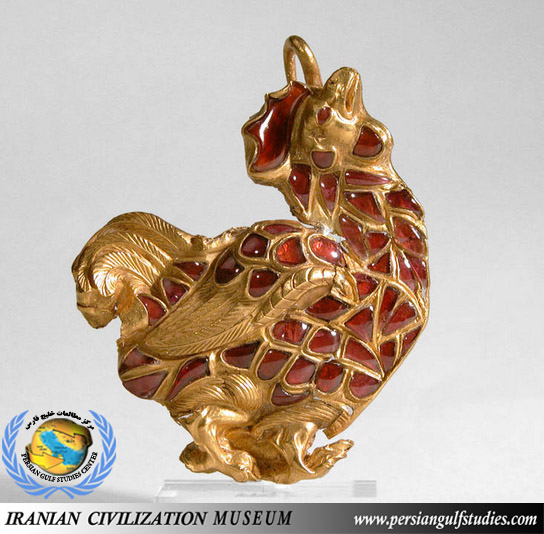 Buckle in the shape of a rooster, Gold and Ruby. The fifth to the seventh century AD (Sassanid period). Private collection, GHIRSHMAN R., Parthes et Sassanides, Paris, 1962
Buckle in the shape of a rooster, Gold and Ruby. The fifth to the seventh century AD (Sassanid period). Private collection, GHIRSHMAN R., Parthes et Sassanides, Paris, 1962
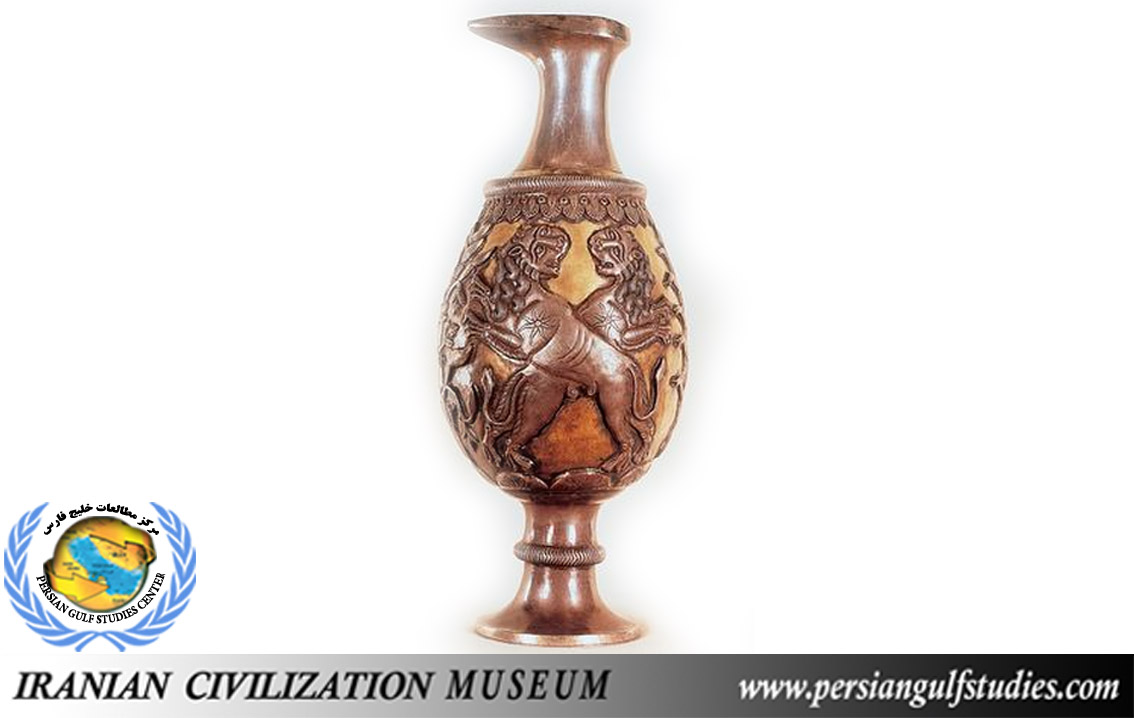 Jar with lion, Silver - Mercury, Seventh century AD, Bibliothèque nationale de France
Jar with lion, Silver - Mercury, Seventh century AD, Bibliothèque nationale de France
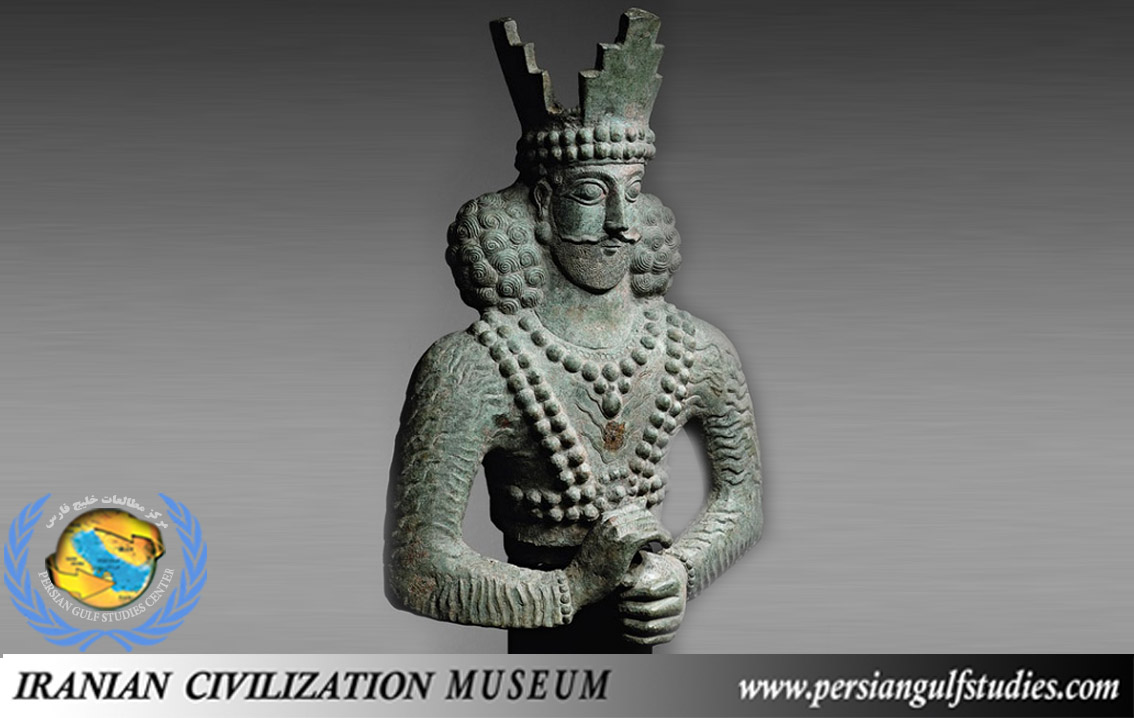 Bronze statue of Shapur I Sassanid, Bronze, fourth century AD, private collection
Bronze statue of Shapur I Sassanid, Bronze, fourth century AD, private collection
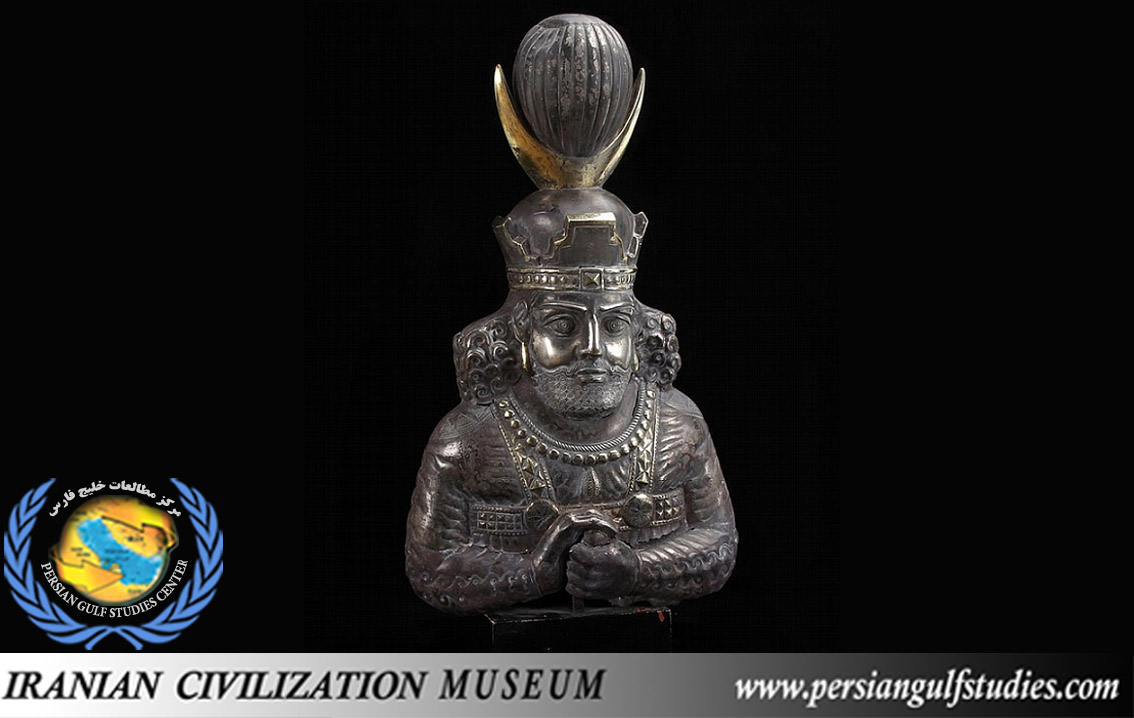 Bust Silver Sassanid Shapur (probably Shapur II 310 to 379 AD) with a thick beard, and crown pendant earrings Congress with a golden crescent, silver, gold, Private collection of fixed.
Bust Silver Sassanid Shapur (probably Shapur II 310 to 379 AD) with a thick beard, and crown pendant earrings Congress with a golden crescent, silver, gold, Private collection of fixed.
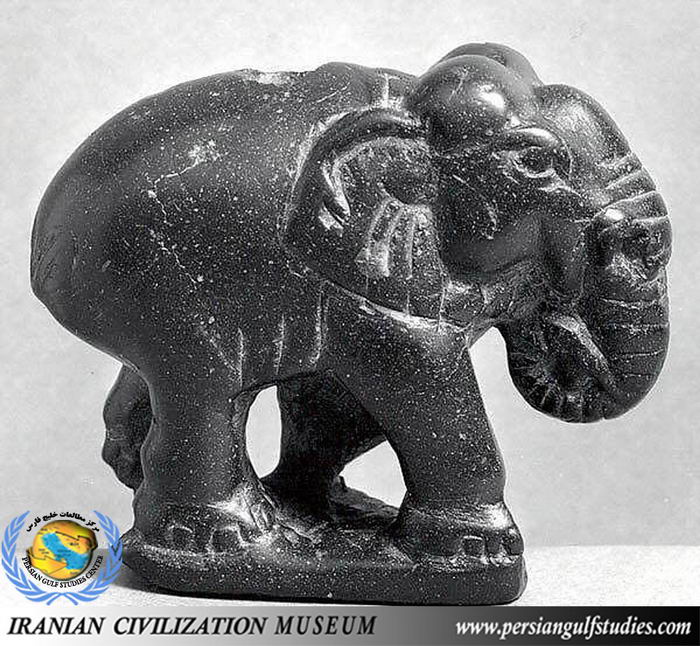 Figure of an elephant, Stone-Sculpture, Sasanian art, ca. 6th–7th century A.D. Mesopotamia. The Metropolitan Museum of Art.
Figure of an elephant, Stone-Sculpture, Sasanian art, ca. 6th–7th century A.D. Mesopotamia. The Metropolitan Museum of Art.
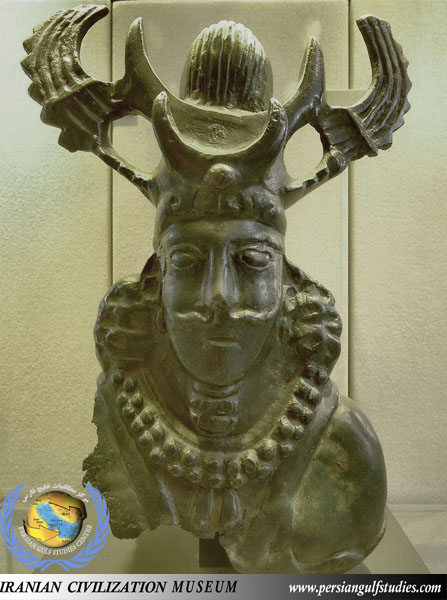 Sasanian king, perhaps Peroz, ca. 400 CE–651 CE, Museum Paris, Louvre.
Sasanian king, perhaps Peroz, ca. 400 CE–651 CE, Museum Paris, Louvre.
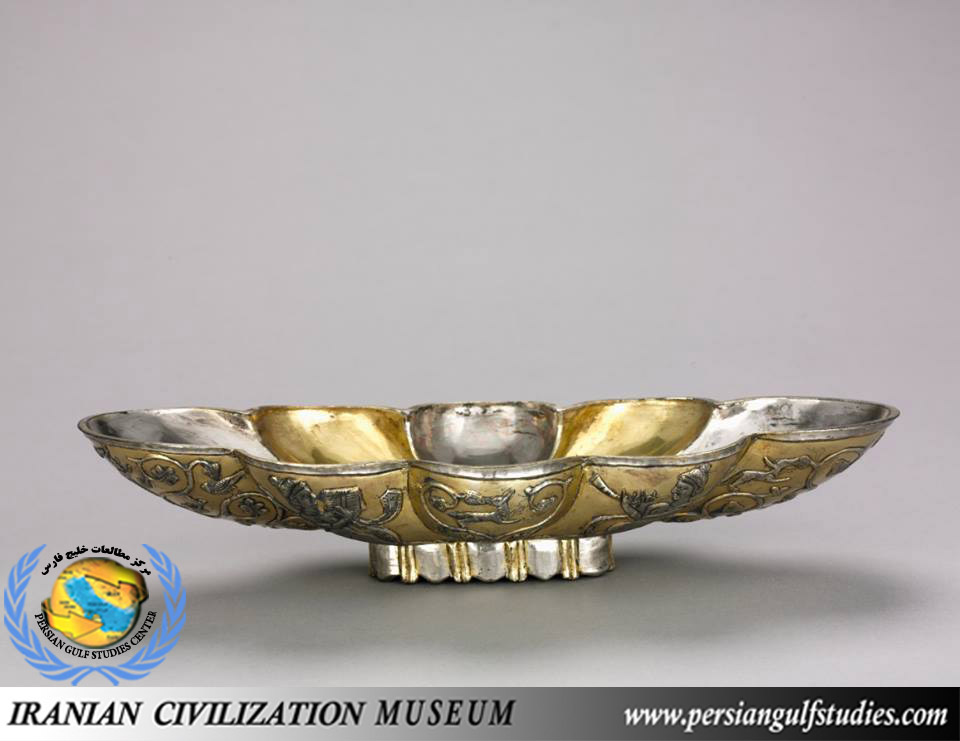 Bowl, Iran, Sasanian art, 4th-6th Century, silver,Cleveland Museum of Art.
Bowl, Iran, Sasanian art, 4th-6th Century, silver,Cleveland Museum of Art.
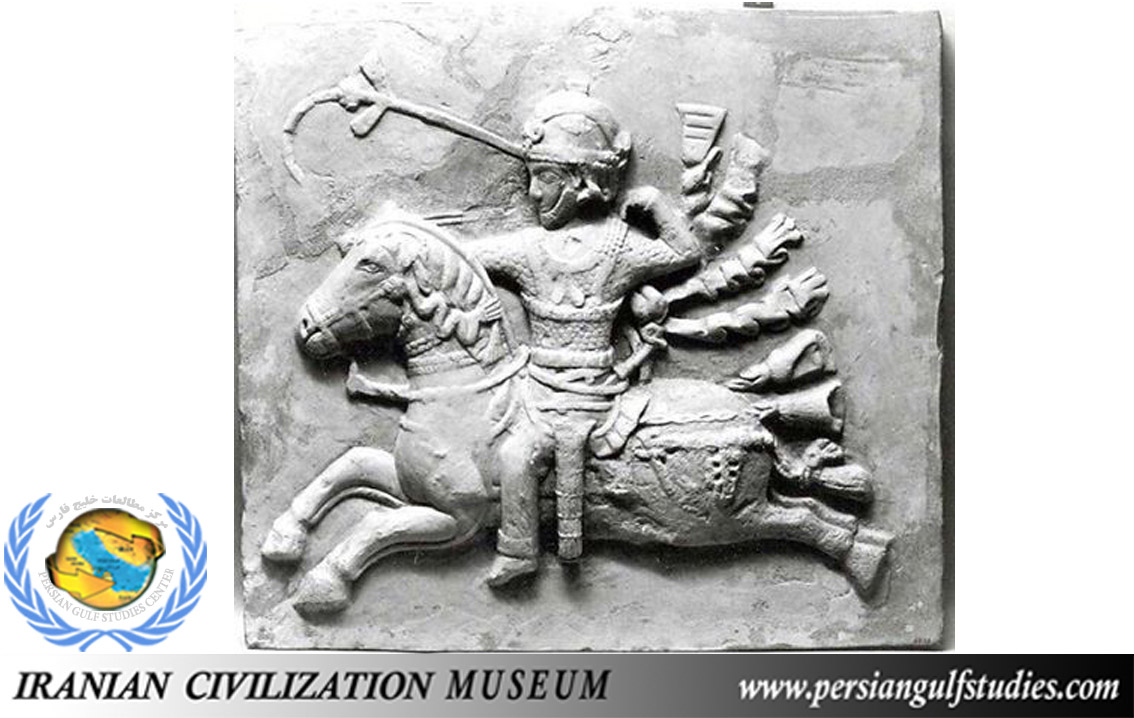 Sasanian Panel, ca. 6th–7th century A.D. Stucco-Reliefs. The Metropolitan Museum of Art : Not on view
Sasanian Panel, ca. 6th–7th century A.D. Stucco-Reliefs. The Metropolitan Museum of Art : Not on view
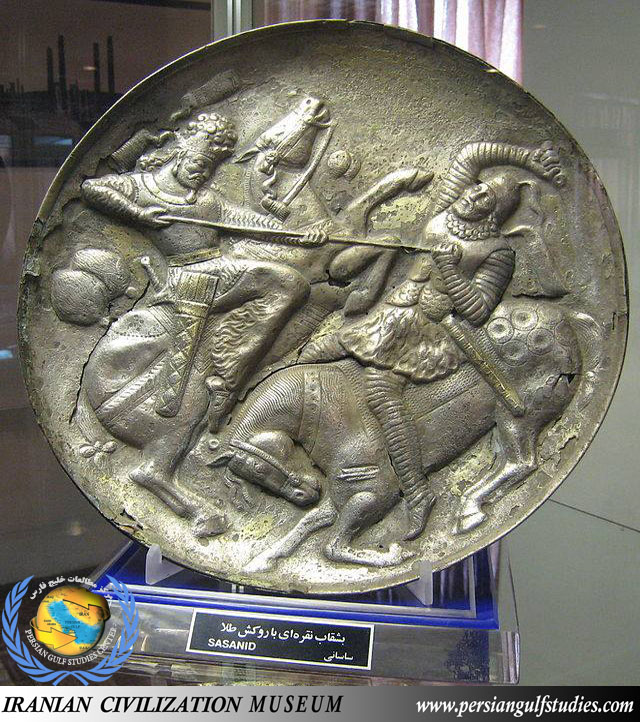 Sasanian silver plate, 224 CE–651 CE, Tabriz, Azarbaijan Museum
Sasanian silver plate, 224 CE–651 CE, Tabriz, Azarbaijan Museum
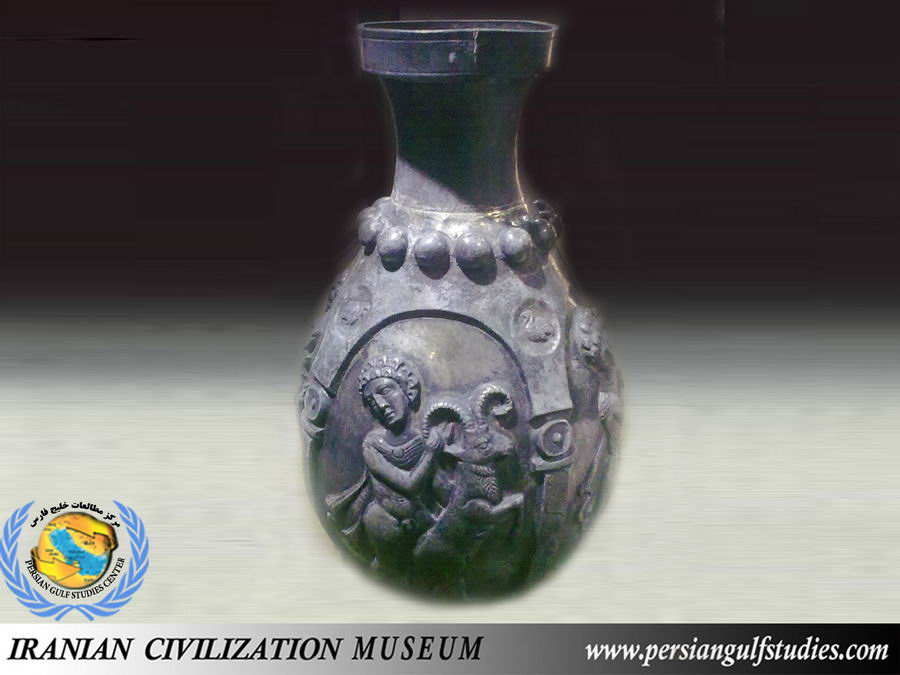 Vase silver, Sassanid art, Reza Abbasi Museum
Vase silver, Sassanid art, Reza Abbasi Museum
 Wall panel with wings and a Pahlavi device encircled by pearls. ca. 6th century A.D. Mesopotamia, Ctesiphon. Stucco-Reliefs-Inscribed. The Metropolitan Museum of Art : Not on view
Wall panel with wings and a Pahlavi device encircled by pearls. ca. 6th century A.D. Mesopotamia, Ctesiphon. Stucco-Reliefs-Inscribed. The Metropolitan Museum of Art : Not on view
 Rhyton Wine horn wih gazelle protome, Iran, Sasanian period, 4th century CE, Silver and gilt, Gift of Arthur M. Sackler, Arthur M. Sackler Gallery.
Rhyton Wine horn wih gazelle protome, Iran, Sasanian period, 4th century CE, Silver and gilt, Gift of Arthur M. Sackler, Arthur M. Sackler Gallery.
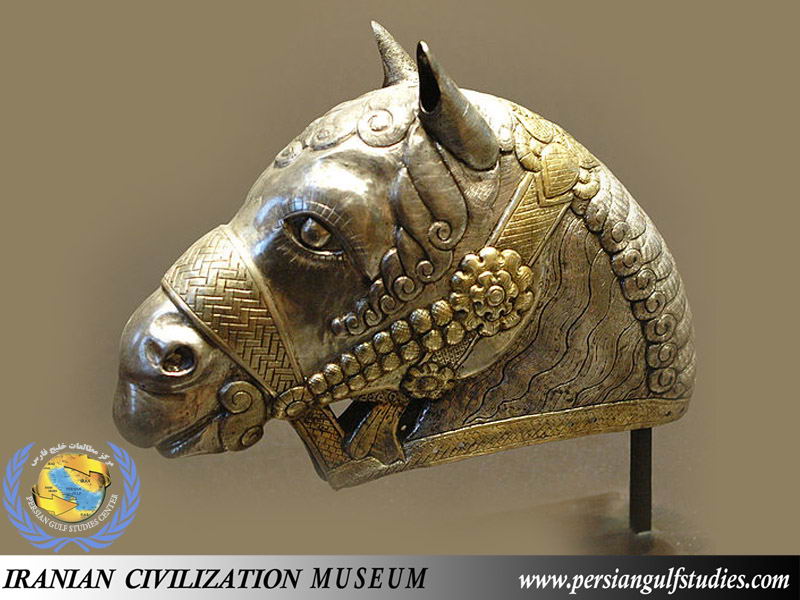 Horse beautiful head, Sassanid art, gilded silver, 4th century, Sasanian art Louvre.
Horse beautiful head, Sassanid art, gilded silver, 4th century, Sasanian art Louvre.
Sassanid Magnificent Heritage
Palaces, temples, tombs, buildings &...
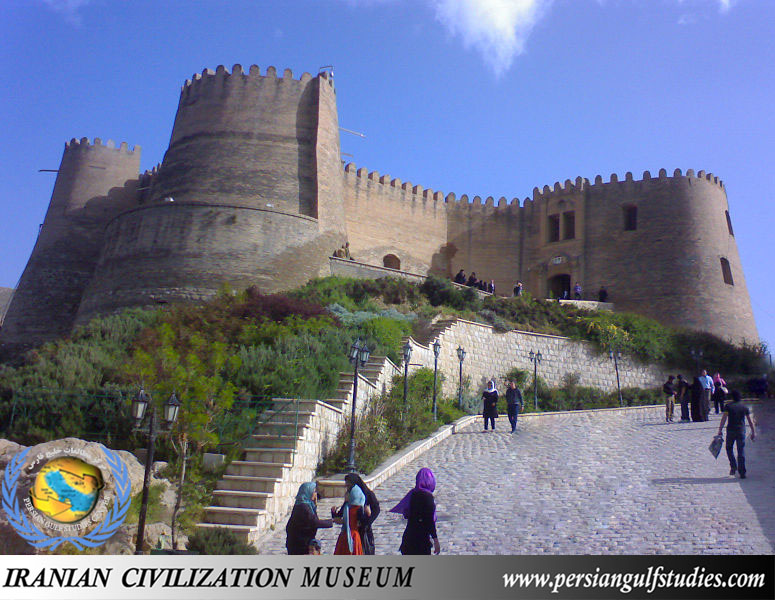 Falak-ol-Aflak Castle is a castle situated on the top of a large hill with the same name within the city of Khorramabad, the regional capital of Lorestan province, Iran. This gigantic and beautiful structure was built during the Sassanid era (226–651).
Falak-ol-Aflak Castle is a castle situated on the top of a large hill with the same name within the city of Khorramabad, the regional capital of Lorestan province, Iran. This gigantic and beautiful structure was built during the Sassanid era (226–651).
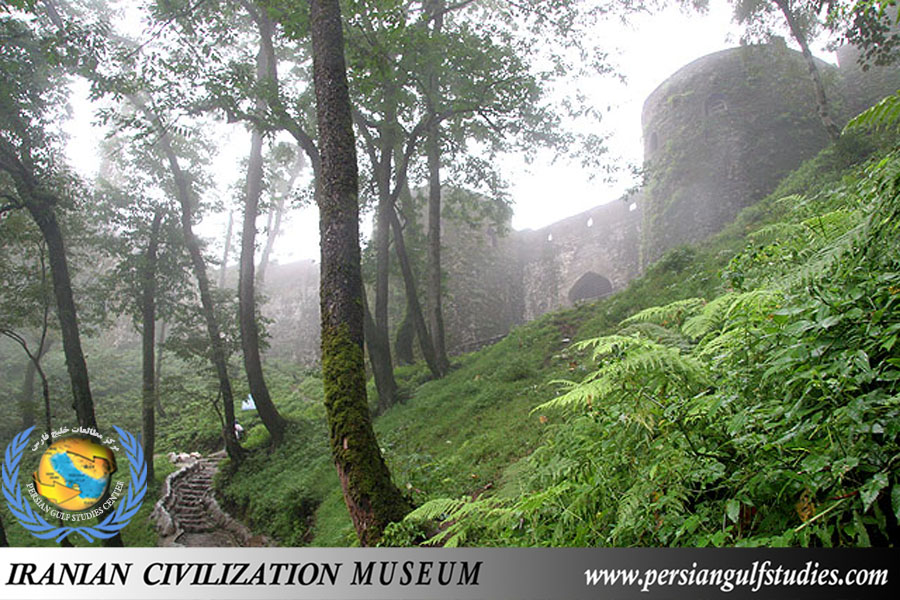 Rudkhan Castle is a brick and stone medieval castle in Iran. Located 25 km southwest of Foman city north of Iran in Gilan province. Its architects have benefited from natural mountainous features in the construction of the fort. After crossing a mountainous winding route with dense forests, the first thing that one notices about the castle is its big entrance gate. The castle's 42 towers still stand intact. This gigantic and beautiful structure was built during the Sassanid era .
Rudkhan Castle is a brick and stone medieval castle in Iran. Located 25 km southwest of Foman city north of Iran in Gilan province. Its architects have benefited from natural mountainous features in the construction of the fort. After crossing a mountainous winding route with dense forests, the first thing that one notices about the castle is its big entrance gate. The castle's 42 towers still stand intact. This gigantic and beautiful structure was built during the Sassanid era .
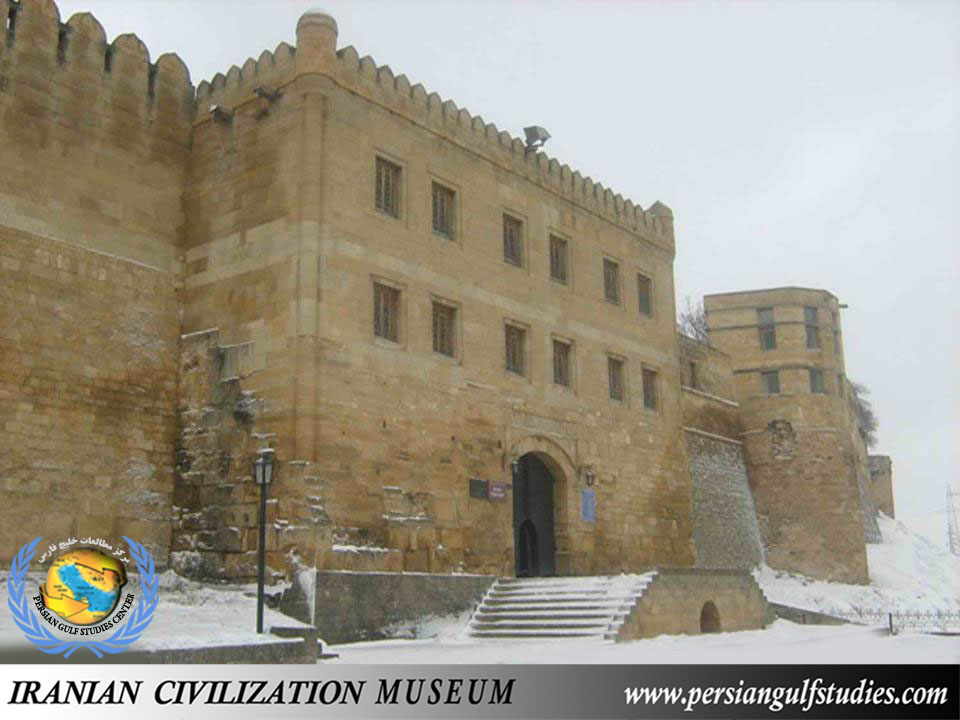 Sassanid fortress in Derbent ( the Republic of Dagestan, Russia), its name in Persian is Darband (Derbent), which means "closed gates". The modern name is a Persian word (دربند Darband) meaning "gateway", which came into use in the end of the 5th or the beginning of the 6th century CE, when the city was re-established by Kavadh I of the Sassanid dynasty of Persia. Derbent was one of the persian cities.
Sassanid fortress in Derbent ( the Republic of Dagestan, Russia), its name in Persian is Darband (Derbent), which means "closed gates". The modern name is a Persian word (دربند Darband) meaning "gateway", which came into use in the end of the 5th or the beginning of the 6th century CE, when the city was re-established by Kavadh I of the Sassanid dynasty of Persia. Derbent was one of the persian cities.
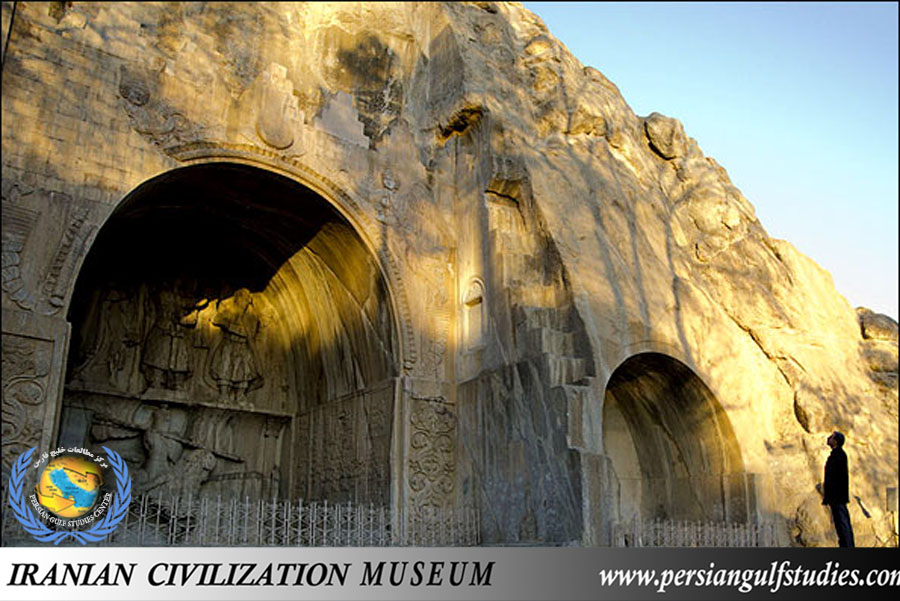 Taq-e Bostan is a site with a series of large rock relief from the era of Sassanid Empire of Persia, the Iranian dynasty which ruled western Asia from 226 to 650 AD. This example of Sassanid art is located 5 km from the city center of Kermanshah in western Iran. It is located in the heart of the Zagros mountains, where it has endured almost 1,700 years of wind and rain. The carvings, some of the finest and best-preserved examples of Persian sculpture under the Sassanids, include representations of the investitures of Ardashir II (379–383) and Shapur III (383–388). Like other Sassanid symbols, Taq-e Bostan and its relief patterns accentuate power, religious tendencies, glory, honor, the vastness of the court, game and fighting spirit, festivity, joy, and rejoicing. Taq-e Bostan and its rock relief are one of the 30 surviving Sassanid relics of the Zagros mountains. According to Arthur Pope, the founder of Iranian art and archeology Institute in the USA, "art was characteristic of the Iranian people and the gift which they endowed the world with."
Taq-e Bostan is a site with a series of large rock relief from the era of Sassanid Empire of Persia, the Iranian dynasty which ruled western Asia from 226 to 650 AD. This example of Sassanid art is located 5 km from the city center of Kermanshah in western Iran. It is located in the heart of the Zagros mountains, where it has endured almost 1,700 years of wind and rain. The carvings, some of the finest and best-preserved examples of Persian sculpture under the Sassanids, include representations of the investitures of Ardashir II (379–383) and Shapur III (383–388). Like other Sassanid symbols, Taq-e Bostan and its relief patterns accentuate power, religious tendencies, glory, honor, the vastness of the court, game and fighting spirit, festivity, joy, and rejoicing. Taq-e Bostan and its rock relief are one of the 30 surviving Sassanid relics of the Zagros mountains. According to Arthur Pope, the founder of Iranian art and archeology Institute in the USA, "art was characteristic of the Iranian people and the gift which they endowed the world with."
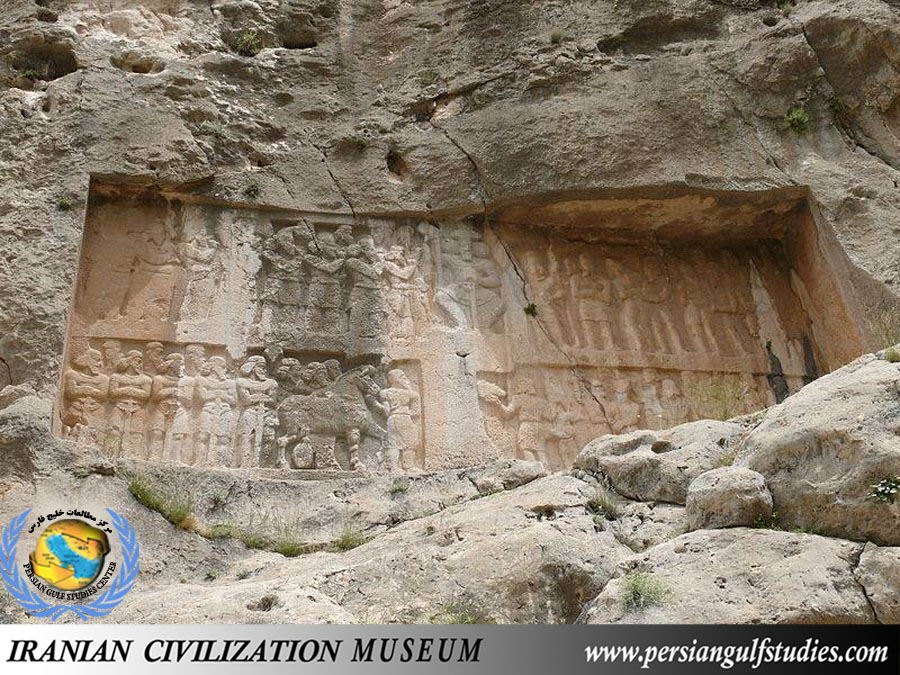 Shapur II In Bishapour, Bishapur was an ancient city in Iran on the ancient road between Persis and Elam. The road linked the Sassanid capitals Estakhr (very close to Persepolis) and Ctesiphon. It is located south of modern Faliyan in the Kazerun County of Pars Province, Iran. Bishapur was built near a river crossing and at the same site there is also a fort with rock-cut reservoirs and a river valley with six Sassanid rock reliefs.
Shapur II In Bishapour, Bishapur was an ancient city in Iran on the ancient road between Persis and Elam. The road linked the Sassanid capitals Estakhr (very close to Persepolis) and Ctesiphon. It is located south of modern Faliyan in the Kazerun County of Pars Province, Iran. Bishapur was built near a river crossing and at the same site there is also a fort with rock-cut reservoirs and a river valley with six Sassanid rock reliefs.
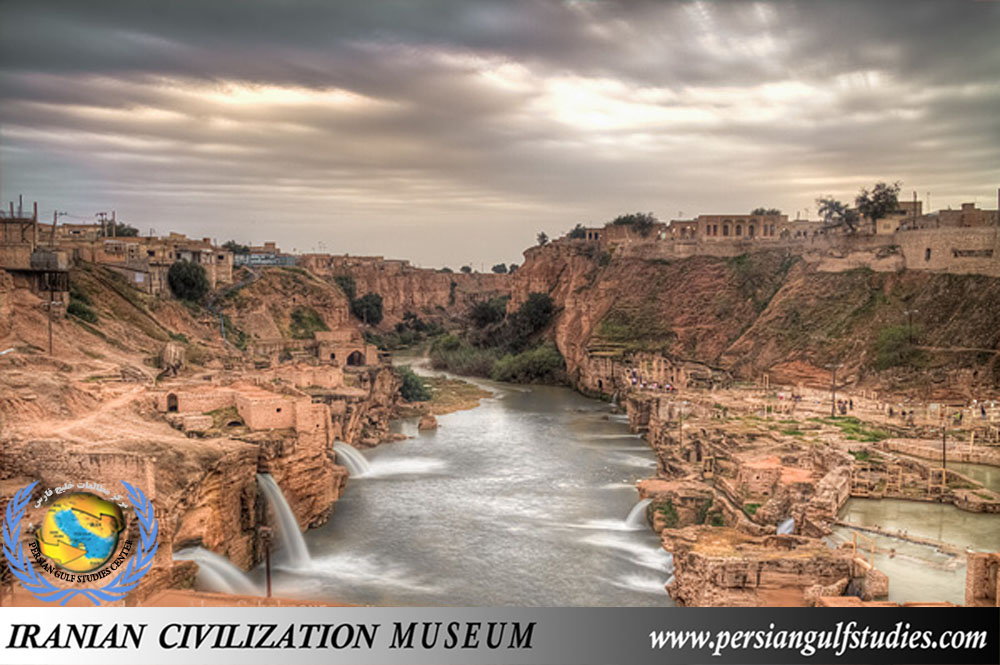 Shushtar Historical Hydraulic System, is an island city from the Sassanid era with a complex irrigation system, situated in Iran's Khuzestan Province.It has been registered on UNESCO's list of World Heritage Sites in 2009, as Iran's 10th cultural heritage site to be registered on the United Nations' list. The Shushtar water mills ones are the best ones which operation in order to use water in ancient periods. These include a collection of dams, tunnels, ancillary canals watermills . which utilized as Industry–Economic collection.
Shushtar Historical Hydraulic System, is an island city from the Sassanid era with a complex irrigation system, situated in Iran's Khuzestan Province.It has been registered on UNESCO's list of World Heritage Sites in 2009, as Iran's 10th cultural heritage site to be registered on the United Nations' list. The Shushtar water mills ones are the best ones which operation in order to use water in ancient periods. These include a collection of dams, tunnels, ancillary canals watermills . which utilized as Industry–Economic collection.
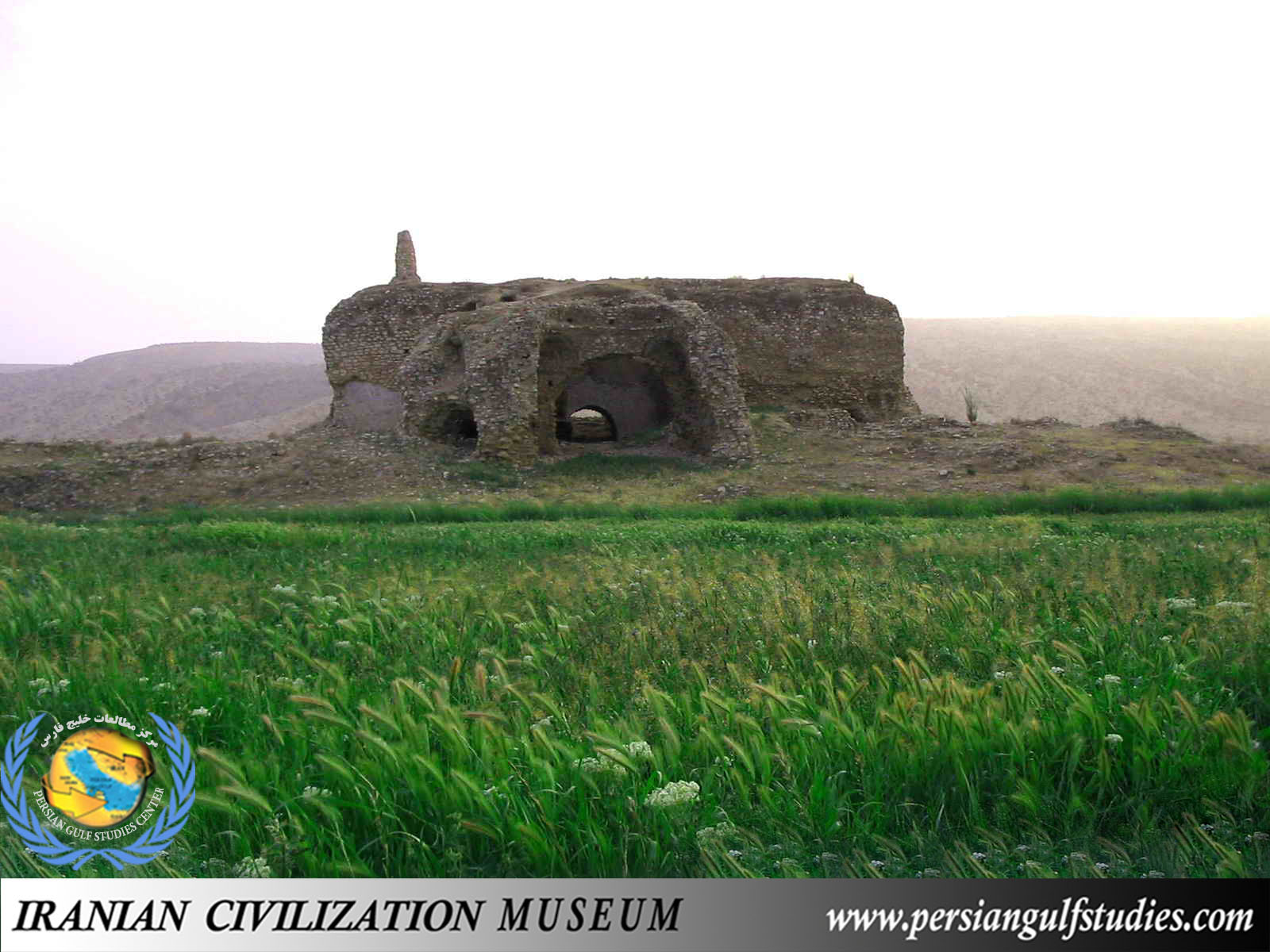 Sasanian Ardeshir Palace, Located in the city of Borazjan, One of the most important historical sites of Bushehr (In southern Iran)
Sasanian Ardeshir Palace, Located in the city of Borazjan, One of the most important historical sites of Bushehr (In southern Iran)
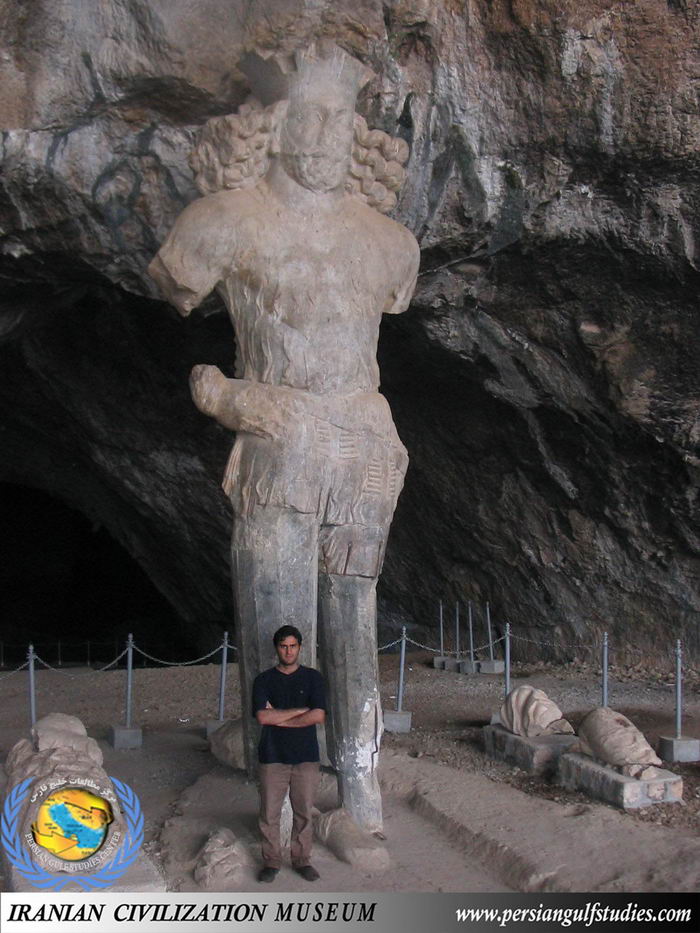 Shapur beautiful cave is located in the Zagros Mountains, in southern Iran, about 6 km from the ancient city of Bishapur. This cave is near Kazerun in Chogan valley, which was the site of polo/chogan in the Sasanian period. In the cave, on the fourth of five terraces, stands the colossal statue of Shapur I, the second ruler of the Sasanid Empire. The statue was carved from one stalagmite. The height of statue is 7 m. high and its shoulders are 2 m. wide, and its hands are 3 m. long. The length of cave entrance is about 16 m., with a height of less than 8 m.Behind the statue, in the depth of the cave, are three ancient water-basins. At both sides of the statue, the rock-walls of the cave were prepared for reliefs by leveling, but the reliefs were never made. It is said that in addition to this giant statue of Shapur I, the tomb of this great man is also situated somewhere in this cave.
Shapur beautiful cave is located in the Zagros Mountains, in southern Iran, about 6 km from the ancient city of Bishapur. This cave is near Kazerun in Chogan valley, which was the site of polo/chogan in the Sasanian period. In the cave, on the fourth of five terraces, stands the colossal statue of Shapur I, the second ruler of the Sasanid Empire. The statue was carved from one stalagmite. The height of statue is 7 m. high and its shoulders are 2 m. wide, and its hands are 3 m. long. The length of cave entrance is about 16 m., with a height of less than 8 m.Behind the statue, in the depth of the cave, are three ancient water-basins. At both sides of the statue, the rock-walls of the cave were prepared for reliefs by leveling, but the reliefs were never made. It is said that in addition to this giant statue of Shapur I, the tomb of this great man is also situated somewhere in this cave.
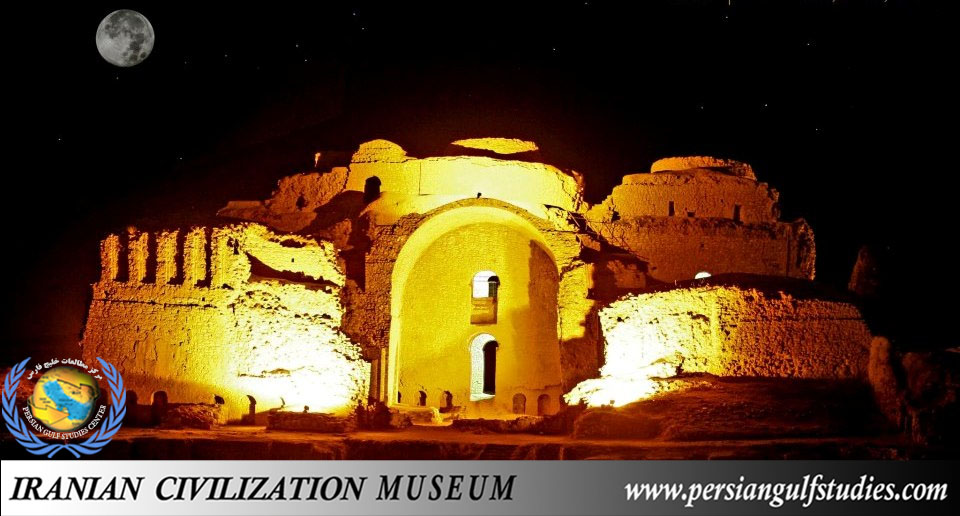 The Palace of Ardashir Pāpakan, also known as the fire temple, is a castle located on the slopes of the mountain on which Dezh Dokhtar is situated on. Built in AD 224 by King Ardashir I of the Sassanian Empire, it is located two kilometers (1.2 miles) north of the ancient city of Gor, i.e. the old city of Piruz-Apad in Pars, in ancient Persia (Iran). From the architectural design, it seems the palace was more of a place of social gathering where guests would be introduced to the imperial throne.
The Palace of Ardashir Pāpakan, also known as the fire temple, is a castle located on the slopes of the mountain on which Dezh Dokhtar is situated on. Built in AD 224 by King Ardashir I of the Sassanian Empire, it is located two kilometers (1.2 miles) north of the ancient city of Gor, i.e. the old city of Piruz-Apad in Pars, in ancient Persia (Iran). From the architectural design, it seems the palace was more of a place of social gathering where guests would be introduced to the imperial throne.
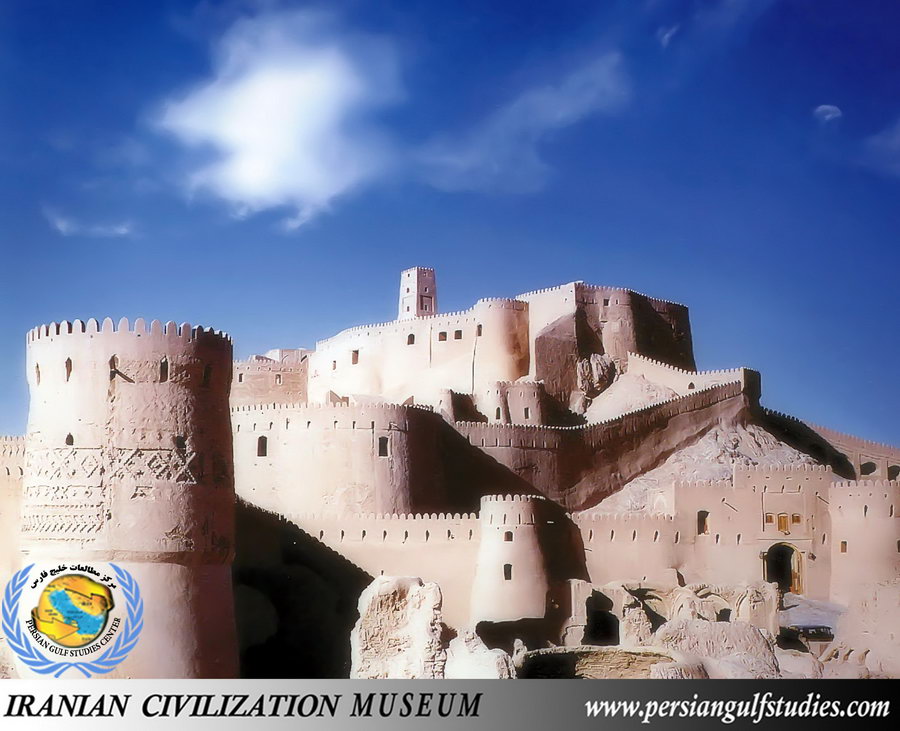 Rayen beautiful Castle is an adobe castle in Kerman province, Iran. The medieval mudbrick city of Rayen is similar to the Arg-e Bam city which was destroyed in an earthquake in December 2003. Rayen displays all the architectural elements of a deserted citadel. It is extremely well preserved, despite numerous natural disasters that have destroyed similar structures nearby, and it is one of the most interesting sites in Iran.
Rayen beautiful Castle is an adobe castle in Kerman province, Iran. The medieval mudbrick city of Rayen is similar to the Arg-e Bam city which was destroyed in an earthquake in December 2003. Rayen displays all the architectural elements of a deserted citadel. It is extremely well preserved, despite numerous natural disasters that have destroyed similar structures nearby, and it is one of the most interesting sites in Iran.
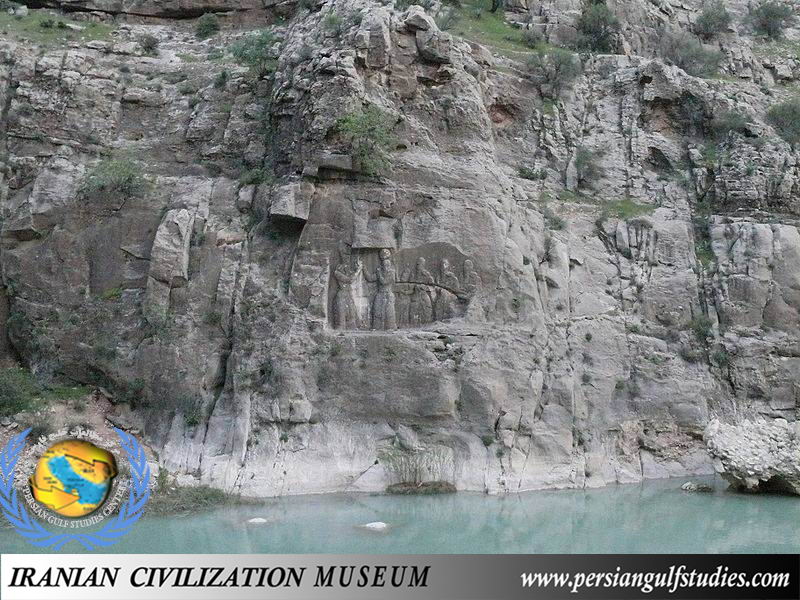 Ancient designs: Sassanian first king Ardashir I (Ardachir Babakan) relief at Firuzaba (Tangab relief). Firuzabad also Romanized as Fīrūzābād; anciently, Sassanid Middle Persian Ardashir-Khwarrah , meaning "The Glory of Ardashir" is a city in and the capital of Firuzabad County, Pars Province (Persian Province), Iran. At the 2006 census, its population was 58,210, in 12,888 families. Alexander of Macedonia destroyed the original city of Gōr. Centuries later, Ardashir I, founder of the Sassanid Dynasty, revived the city before it was ransacked during the Arab invasion of the seventh century. Firuzabad is situated in a low-lying area of the region, so Alexander was able to drown the city by directing the flow of a river into the city. The lake he created remained until Ardashir I built a tunnel to drain it. He founded his new capital city on this site. Ardashir's new city was known as Khor Ardashīr, Ardashīr Khurah and Shāhr-ī Gōr. It had a circular plan so precise in measurement that the Persian historian Ibn Balkhi wrote it to be "devised using a compass".
Ancient designs: Sassanian first king Ardashir I (Ardachir Babakan) relief at Firuzaba (Tangab relief). Firuzabad also Romanized as Fīrūzābād; anciently, Sassanid Middle Persian Ardashir-Khwarrah , meaning "The Glory of Ardashir" is a city in and the capital of Firuzabad County, Pars Province (Persian Province), Iran. At the 2006 census, its population was 58,210, in 12,888 families. Alexander of Macedonia destroyed the original city of Gōr. Centuries later, Ardashir I, founder of the Sassanid Dynasty, revived the city before it was ransacked during the Arab invasion of the seventh century. Firuzabad is situated in a low-lying area of the region, so Alexander was able to drown the city by directing the flow of a river into the city. The lake he created remained until Ardashir I built a tunnel to drain it. He founded his new capital city on this site. Ardashir's new city was known as Khor Ardashīr, Ardashīr Khurah and Shāhr-ī Gōr. It had a circular plan so precise in measurement that the Persian historian Ibn Balkhi wrote it to be "devised using a compass".
 Ancient statue of Mithraism in italy, Art of Sassanid Persian empire
Ancient statue of Mithraism in italy, Art of Sassanid Persian empire
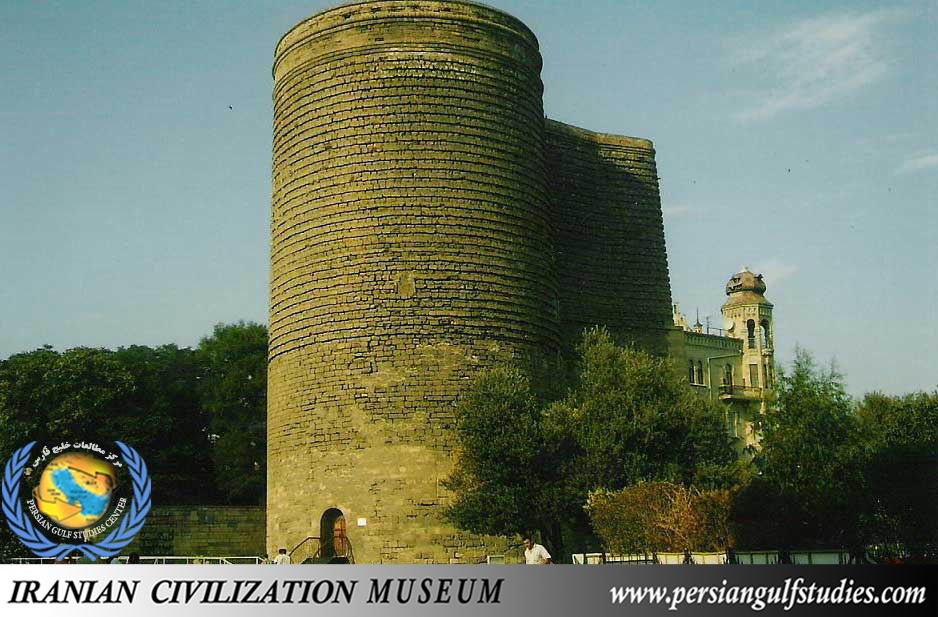 The Maiden Tower, located in the Old City, Baku, in Azerbaijan, was built in the 12th century as part of the walled city. Together with the Shirvanshahs' Palace, dated to the 15th century, it forms an ensemble of historic monuments inscribed in 2001 under the UNESCO World Heritage List of Historical Monuments as cultural property, Category III. The Maiden Tower Built in Sassanian period. Republic of Azerbaijan was one of the Iranian cities.
The Maiden Tower, located in the Old City, Baku, in Azerbaijan, was built in the 12th century as part of the walled city. Together with the Shirvanshahs' Palace, dated to the 15th century, it forms an ensemble of historic monuments inscribed in 2001 under the UNESCO World Heritage List of Historical Monuments as cultural property, Category III. The Maiden Tower Built in Sassanian period. Republic of Azerbaijan was one of the Iranian cities.
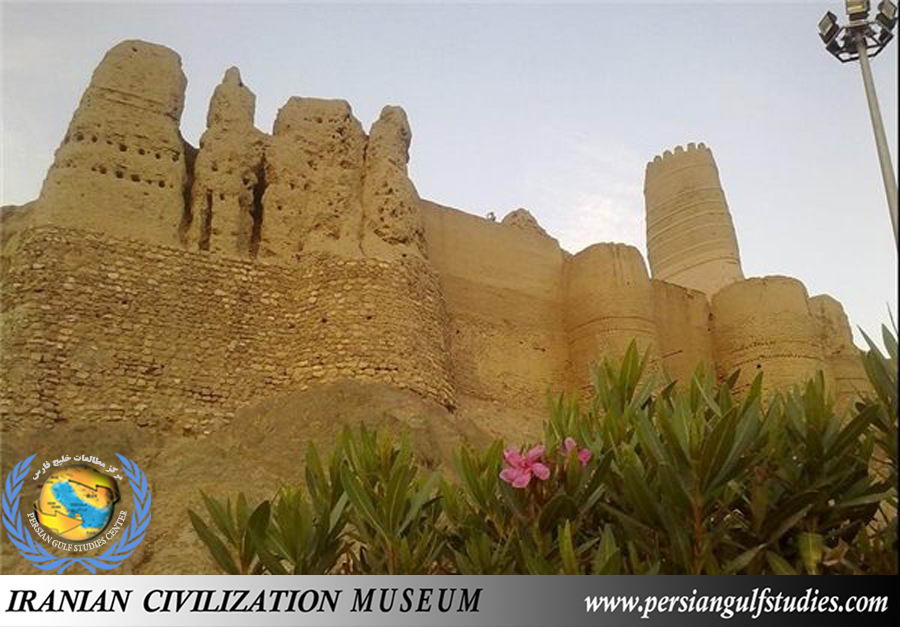 Manujan Castle in Kerman Province, Iran. Manujan Castle from Sasanian architecture
Manujan Castle in Kerman Province, Iran. Manujan Castle from Sasanian architecture
 Stone Columns of Bishapour, Sasanian palace in Kazerun
Stone Columns of Bishapour, Sasanian palace in Kazerun
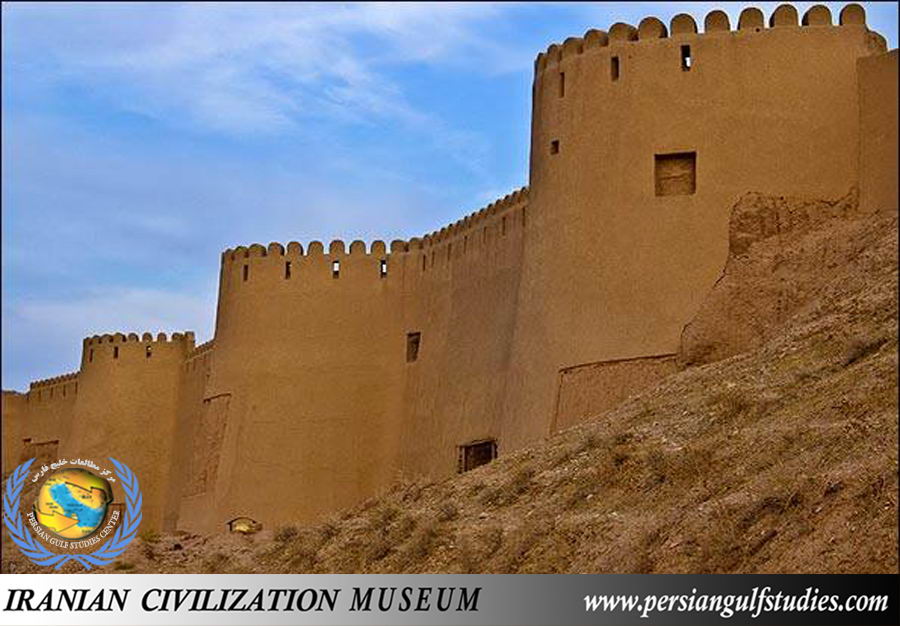 Belqeys Castle in North Khorasan Iran. Architecture Belqeys Castle According to the Sassanid architecture. The castle has 4 thousand years And in North Khorasan Esfaraen. Historic castle with 51 thousand square meters. This castle 29 towers, each tower is 11 meters high. Located on the Silk Road.
Belqeys Castle in North Khorasan Iran. Architecture Belqeys Castle According to the Sassanid architecture. The castle has 4 thousand years And in North Khorasan Esfaraen. Historic castle with 51 thousand square meters. This castle 29 towers, each tower is 11 meters high. Located on the Silk Road.
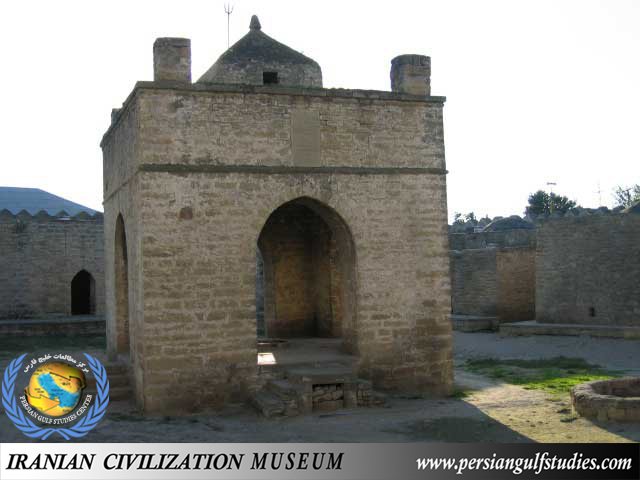 The Baku Ateshgah "Fire Temple" is an castle-like religious temple in Surakhani, a suburb of greater Baku, Azerbaijan. Based on Persian, iranian inscriptions, temple was used as a Zoroastrian fire worship place. atash is the Persian word for fire. Because Azerian Peoples in baku were Zoroastrian and also a part of iran.
The Baku Ateshgah "Fire Temple" is an castle-like religious temple in Surakhani, a suburb of greater Baku, Azerbaijan. Based on Persian, iranian inscriptions, temple was used as a Zoroastrian fire worship place. atash is the Persian word for fire. Because Azerian Peoples in baku were Zoroastrian and also a part of iran.
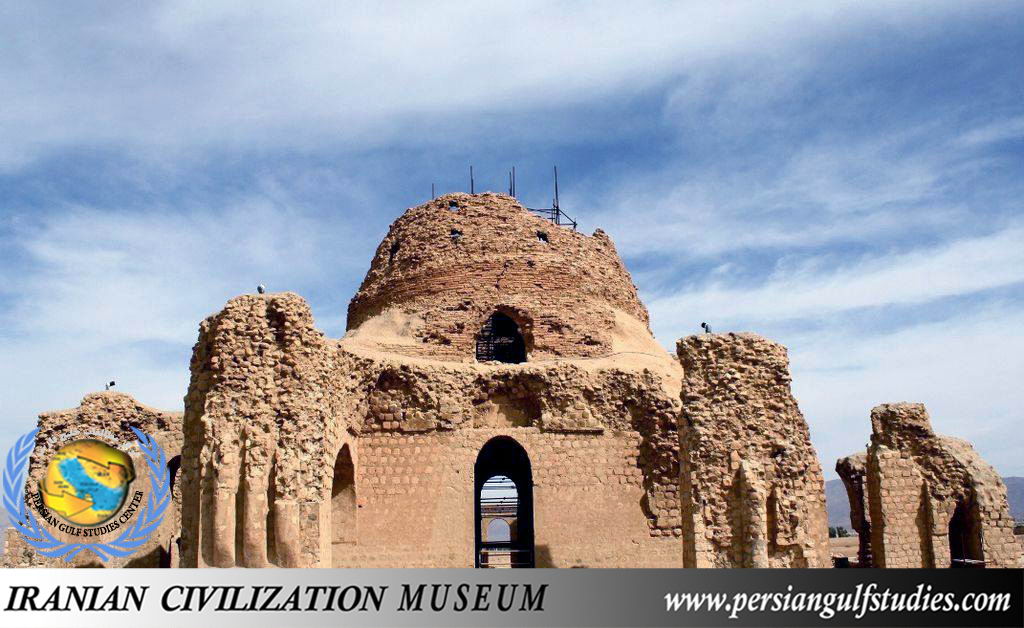 The Sassanid Palace at Sarvestan is a Sassanid-era building in the Iranian city of Sarvestan, some 90 km southeast from the city of Shiraz. The palace was built in the 5th century AD, and was either a gubernatorial residence or a Zoroastrian fire temple. The Sarvestan Palace was built by the Sasanian king Bahramgur (r. 420-438), and dominates an immense, empty plain. The building reminds one of the Ghal'eh Dokhtar and the palace of Ardashir, both near Firuzabad; the difference is that the Sarvestan palace is open to all sides. The building, made of stone and mortar, must have had fine decorations, which partly survive.
The Sassanid Palace at Sarvestan is a Sassanid-era building in the Iranian city of Sarvestan, some 90 km southeast from the city of Shiraz. The palace was built in the 5th century AD, and was either a gubernatorial residence or a Zoroastrian fire temple. The Sarvestan Palace was built by the Sasanian king Bahramgur (r. 420-438), and dominates an immense, empty plain. The building reminds one of the Ghal'eh Dokhtar and the palace of Ardashir, both near Firuzabad; the difference is that the Sarvestan palace is open to all sides. The building, made of stone and mortar, must have had fine decorations, which partly survive.
 Barm-e Delak - Bahram's heart. It shows the king( Bahram II) offering a lotus flower to his wife. Barm-e Delak is a site of a Sasanian rock relief located about 10 km southeast of Shiraz, in the Pars Province of Iran. The rock relief was known as Bahram-e Dundalk in Middle Persian, which means Bahram's heart. The site is located near a river, on the eastern side of a rocky spur. It composes four reliefs.The first relief is a family scene done in a unique style in honor to king Bahram II. It shows the king offering a lotus flower to his wife.
Barm-e Delak - Bahram's heart. It shows the king( Bahram II) offering a lotus flower to his wife. Barm-e Delak is a site of a Sasanian rock relief located about 10 km southeast of Shiraz, in the Pars Province of Iran. The rock relief was known as Bahram-e Dundalk in Middle Persian, which means Bahram's heart. The site is located near a river, on the eastern side of a rocky spur. It composes four reliefs.The first relief is a family scene done in a unique style in honor to king Bahram II. It shows the king offering a lotus flower to his wife.
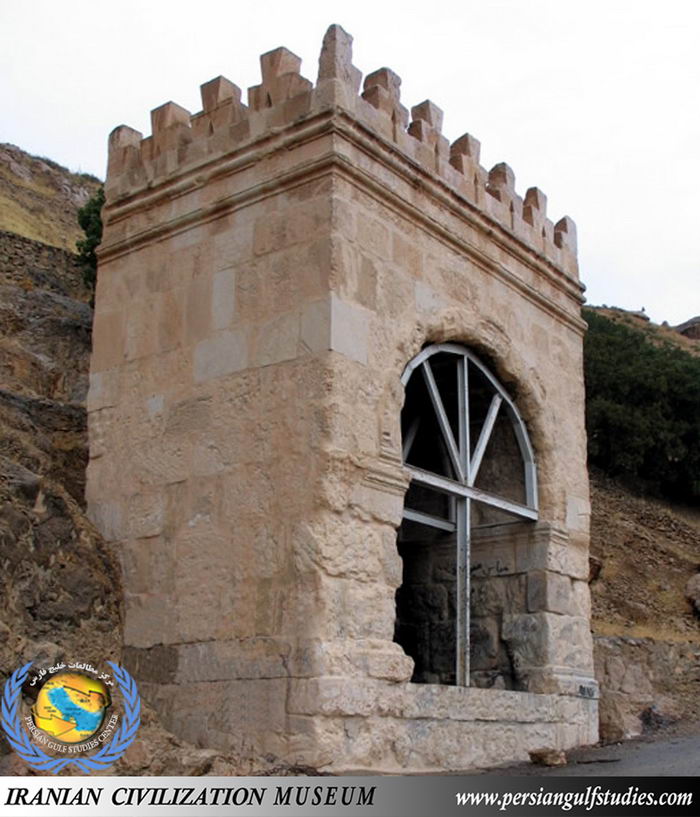 Taq-e Gara: There are conflicting views as to the time of its construction. Parthian and Sassanid eras have been proposed, but most archeologists and historians believe that it has been built during late Sassanid Empire for a variety of reasons. Access and attributes The monument is located on the old road from Kermanshah to Qasr-e Shirin with the new road overlooking it. It is about a five hundred meters walk away from the main road.
Taq-e Gara: There are conflicting views as to the time of its construction. Parthian and Sassanid eras have been proposed, but most archeologists and historians believe that it has been built during late Sassanid Empire for a variety of reasons. Access and attributes The monument is located on the old road from Kermanshah to Qasr-e Shirin with the new road overlooking it. It is about a five hundred meters walk away from the main road.
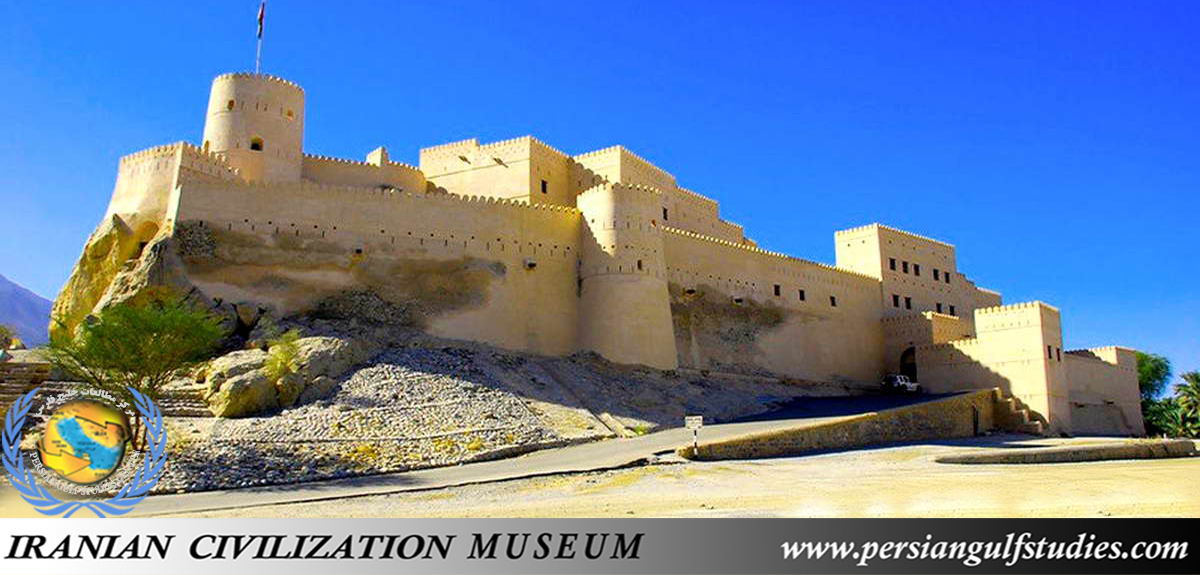 Rustaq Castle (Al-Rustaq) in the Al Batinah Region of northern Oman. The wilayah of Rustaq is in the Western Hajar, in the south of the Batinah. Rustaq was once the capital of Oman, during the era of Imam Nasir bin Murshid al Ya'arubi. This gigantic and beautiful structure was built during the Sassanid era. Oman was one of the Iranian cities..
Rustaq Castle (Al-Rustaq) in the Al Batinah Region of northern Oman. The wilayah of Rustaq is in the Western Hajar, in the south of the Batinah. Rustaq was once the capital of Oman, during the era of Imam Nasir bin Murshid al Ya'arubi. This gigantic and beautiful structure was built during the Sassanid era. Oman was one of the Iranian cities..
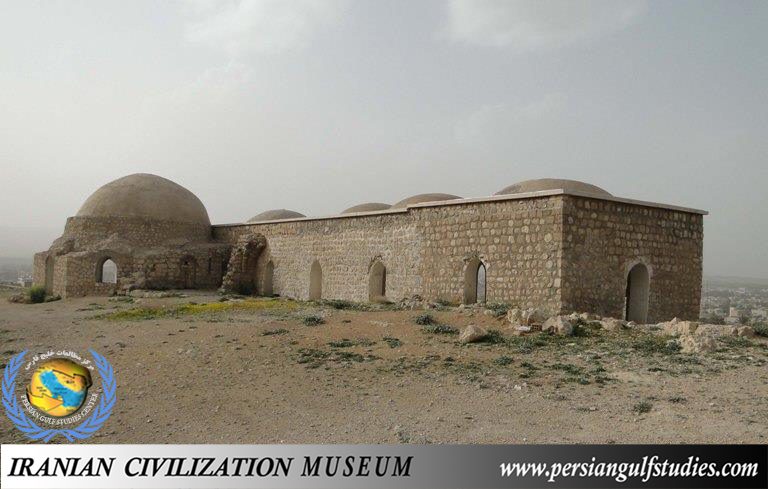 fire temple of Sassanian in the Jahrom ( FARS province) near Shiraz. Jahrom is a city in and the capital of Jahrom County, Fars Province, Iran. Jahrom is located 190 kilometres (120 mi) southeast of Shiraz, the capital of Fars Province.
fire temple of Sassanian in the Jahrom ( FARS province) near Shiraz. Jahrom is a city in and the capital of Jahrom County, Fars Province, Iran. Jahrom is located 190 kilometres (120 mi) southeast of Shiraz, the capital of Fars Province.
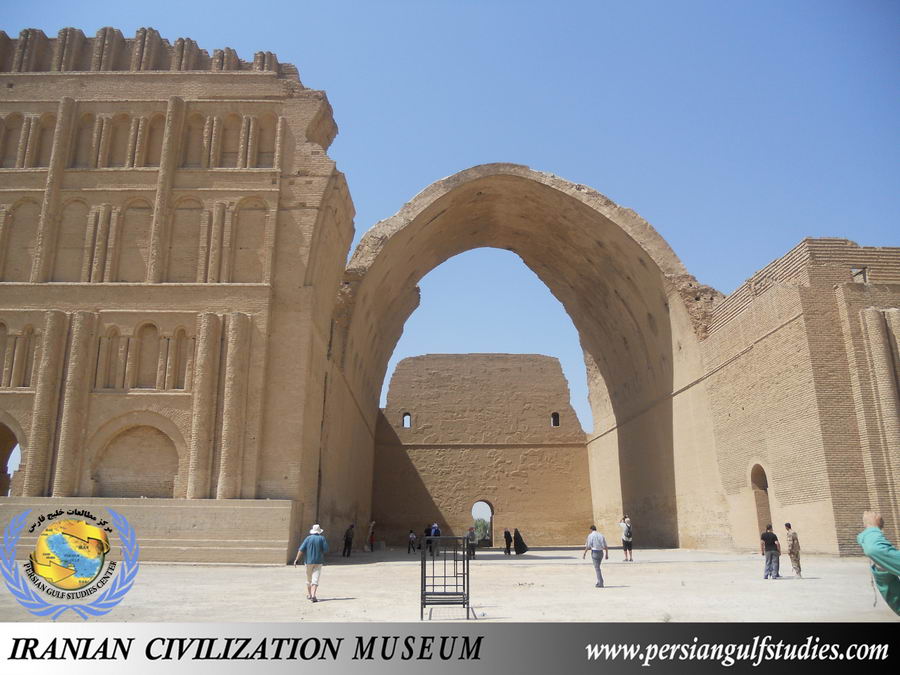 Ctesiphon Sassanid beautiful place, Ctesiphon was the imperial capital of the Sasanian & Parthian. It was one of the great cities of late ancient Mesopotamia. Its most conspicuous structure remaining today is the great archway of Ctesiphon. Ctesiphon was founded in the late 120s BC. It was built on the site of a military camp established across from Seleucia by Mithridates I of Parthia. The reign of Gotarzes I saw Ctesiphon reach a peak as a political and commercial center. Iraq was part of Iranian territory.
Ctesiphon Sassanid beautiful place, Ctesiphon was the imperial capital of the Sasanian & Parthian. It was one of the great cities of late ancient Mesopotamia. Its most conspicuous structure remaining today is the great archway of Ctesiphon. Ctesiphon was founded in the late 120s BC. It was built on the site of a military camp established across from Seleucia by Mithridates I of Parthia. The reign of Gotarzes I saw Ctesiphon reach a peak as a political and commercial center. Iraq was part of Iranian territory.
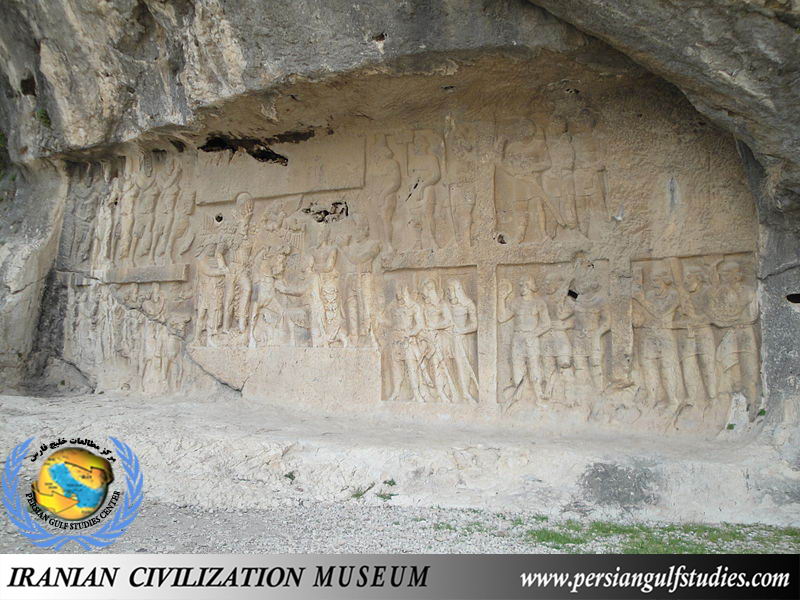 The rock relief of Shapur I victory at Tang-e Chogan gorge, Bishapur.Bishapur was an ancient city in Iran on the ancient road between Persis and Elam. The road linked the Sassanid capitals Estakhr (very close to Persepolis) and Ctesiphon. Bishapur, Shapur's City. Outside the city, Shapur decorated the sides of the Bishapur River gorge with huge historical reliefs commemorating his triple triumph over Rome. One of these reliefs, in a semicircular shape, has rows of registers with files of soldiers and horses, in a deliberate imitation of the narrative scenes on the Trajan column in Rome. According to an inscription, the city itself was founded in 266 by Shapur I (241-272), who was the second Sassanid king and inflicted a triple defeat on the Romans, having killed Gordian III, captured Valerian and forced Philip the Arab to surrender.
The rock relief of Shapur I victory at Tang-e Chogan gorge, Bishapur.Bishapur was an ancient city in Iran on the ancient road between Persis and Elam. The road linked the Sassanid capitals Estakhr (very close to Persepolis) and Ctesiphon. Bishapur, Shapur's City. Outside the city, Shapur decorated the sides of the Bishapur River gorge with huge historical reliefs commemorating his triple triumph over Rome. One of these reliefs, in a semicircular shape, has rows of registers with files of soldiers and horses, in a deliberate imitation of the narrative scenes on the Trajan column in Rome. According to an inscription, the city itself was founded in 266 by Shapur I (241-272), who was the second Sassanid king and inflicted a triple defeat on the Romans, having killed Gordian III, captured Valerian and forced Philip the Arab to surrender.
